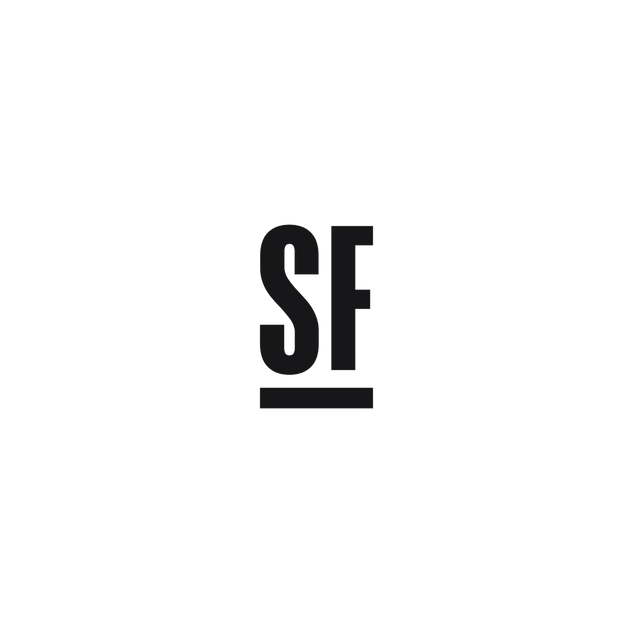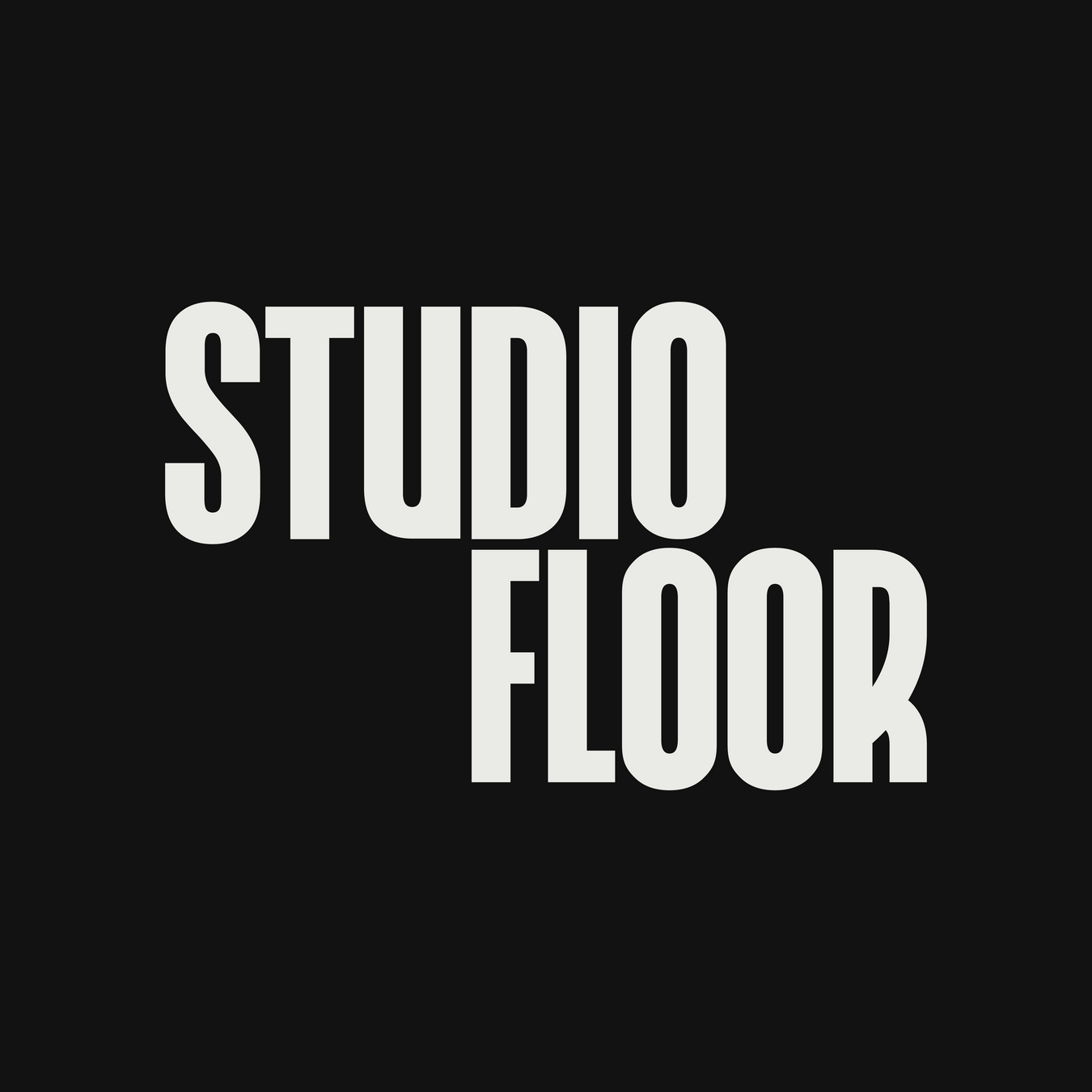
studiofloorscotland@gmail.com
THE LATEST - WHAT'S ON IN APRIL

EXHIBITION
SATURDAY 15 APR - SATURDAY 29 APR 2023
The STUDIO FLOOR Exhibition will open on Saturday 15 April to Saturday 29 April 2023 in the most beautiful space at The Pyramid at Anderston. The exhibition will be open Wednesday-Saturday from 12-4pm.
Come along to see our unique collection of couture pieces made from textile waste from the studios of ReJean Denim and Christopher McEvoy. We're creating a roadmap for other creatives for collaboration and sustainability.
EXHIBITION OPENING TIMES
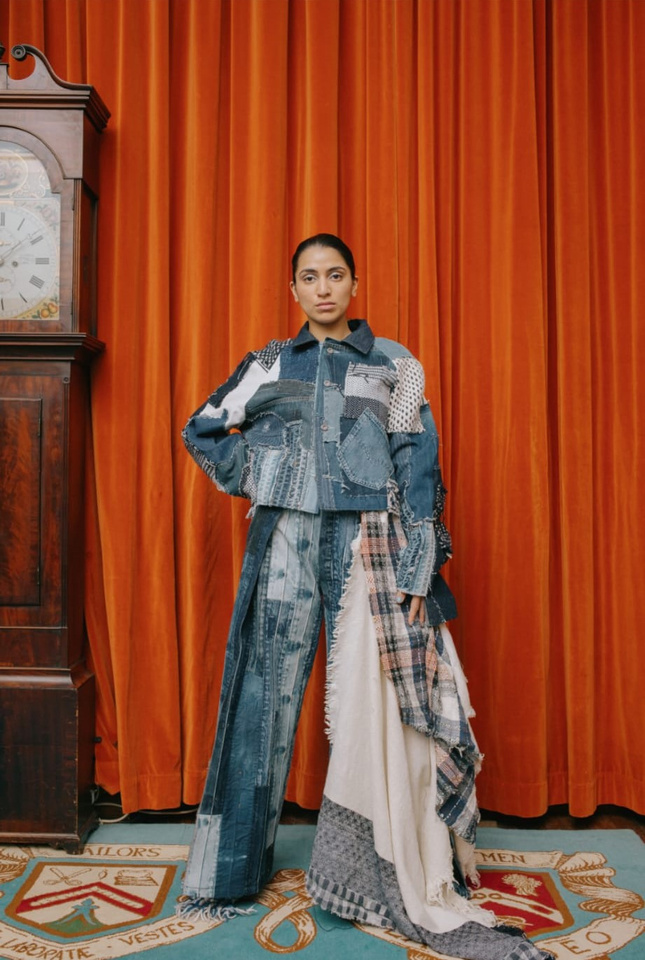
Saturday 15 Apr : 12 - 4pm
Wednesday 19 Apr: 12 - 8pm
Late opening with a free Panel Event from 5.30 pm onwards. We will be discussing the challenges and rewards of running a business focused on sustainability, with Izzie, Belocine and Siobhan.
Thursday 20 Apr: 12 - 4pm
Friday 21 Apr: 12 - 4pm
Saturday 22 Apr: 12 - 4pm
Wednesday 26 Apr: 12 - 8pm
Late opening with free Panel Event from 5.30 pm onwards. We will be discussing collaboration and the impact that remote working has on this.
Thursday 27 Apr: 12 - 4pm
Friday 28 Apr: 12 - 4pm
Saturday 29 Apr: 12 - 4pm
We will be hosting a Live 'in conversation' with the creators behind STUDIO FLOOR, Siobhan and Christopher, (MORE DETAILS COMING SOON)
EXHIBITION LOCATION: THE PYRAMID AT ANDERSTON, 759 ARGYLE STREET, GLASGOW, G3 8DS

PANEL EVENTS
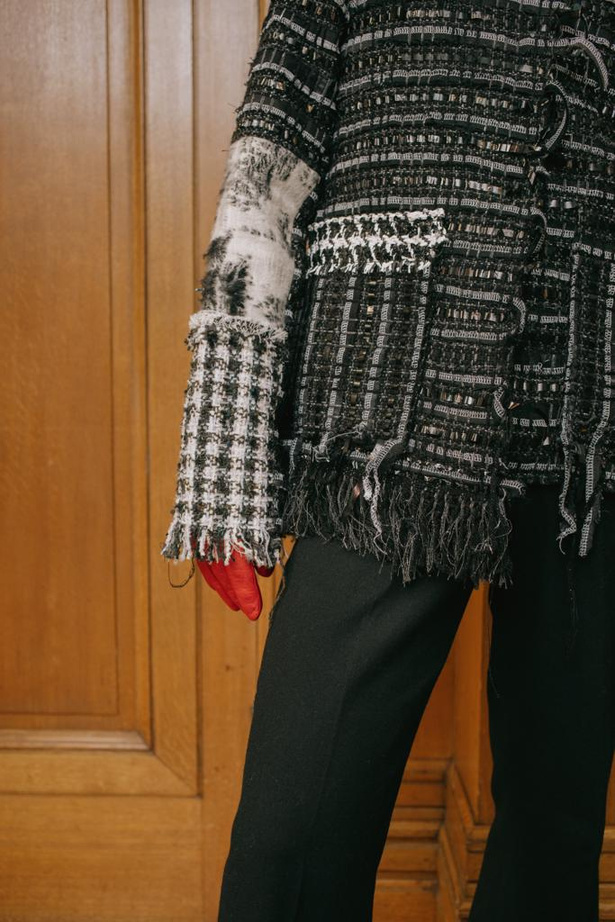
SUSTAINABILITY AND FASHION BUSINESS - PANEL
THE PYRAMID AT ANDERSTON, GLASGOW.
WEDNESDAY 19 APRIL 2023 - 5.30 FOR 6PM START
Join one of the creatives behind the STUDIO FLOOR exhibition, Siobhan McKenna, for a panel discussion on sustainability and Fashion Business.
The panel guests are Izzie Eriksen, founder of ApparelXchange and Belocine Musolo, the French and Congolese fashion designer behind Nephtali Couture.
Guest bios:
Izzie Eriksen (ApparelXchange): Izzie Eriksen, based in Glasgow, founded ‘ApparelXchange’ which has repurposed over 6,500 items of clothing, saving the carbon equivalent of taking 10 cars off the road for a year while simultaneously helping low income families with free clothes and uniform.
Belocine Musolo (Nephtali Couture) : Belocine Musolo is a French French and Congolese fashion designer who moved to Scotland and set up her double-culture inspired fashion brand 'Nephtali Couture' - offering a selection of handmade modern and stylish garments and accessories using traditional fabrics.
The Panel Discussion starts at 6pm sharp and the exhibition will be open for viewing beforehand and for a brief time after the panel talk.
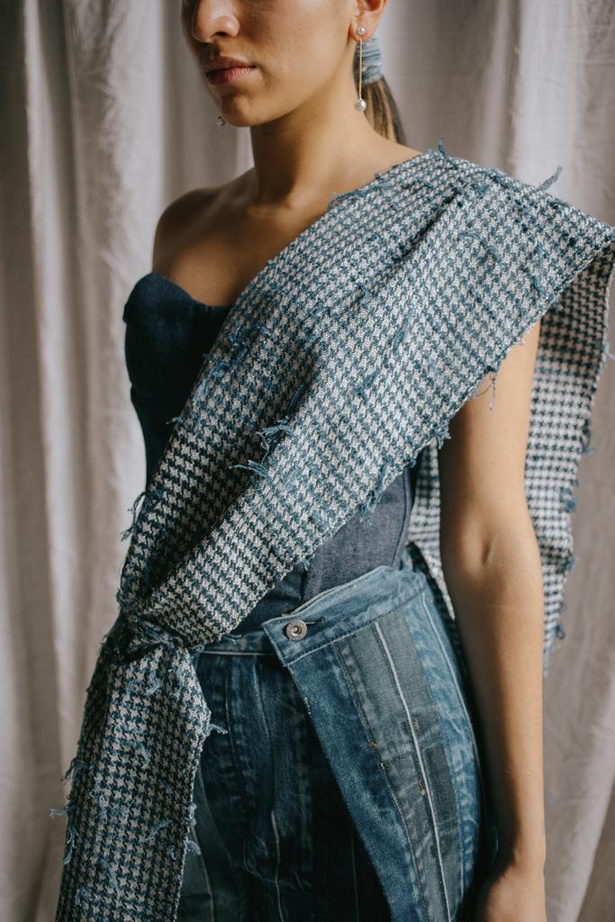
COLLABORATION, REMOTE DESIGN, SCOTLAND - PANEL
THE PYRAMID AT ANDERSTON, GLASGOW.
WEDNESDAY 19 APRIL 2023 - 5.30 FOR 6PM START
Join one of the creatives behind the STUDIO FLOOR exhibition, Christopher McEvoy, for a panel discussion on creative collaboration and the impact that working remotely and away from traditional centres and hubs has on this type of work.
The panel guests are Scottish artist and textile colourist Caven Jayne Macpherson and Scottish designer and highly skilled maker Deryck Walker.
Guest bios:
Caven Jayne Macpherson: Cavan is a Scottish artist who graduated with a Masters Degree in Womenswear Knit from The Royal College of Art. Her Masters work explored a passion in fusing sculptural knitwear from woven silks, meanwhile building an archive of ethical fabrication and colour pigment. She now works between Scotland & London focusing in special projects, education, natural/low impact colour pigment and biodiversity within fashion/textiles.
Deryck Walker: Scottish designer Deryck Walker has evolved from producing RTW collections while working in a fast paced industry, to focusing on a slower, more meaningful approach to his design. Taking his skills and experience, Deryck has applied the same craftsmanship and quality to his present practice. Creating and working on projects from tailoring to the restoration of upholstery.
The Panel Discussion starts at 6pm sharp and the exhibition will be open for viewing beforehand and for a brief time after the panel talk.
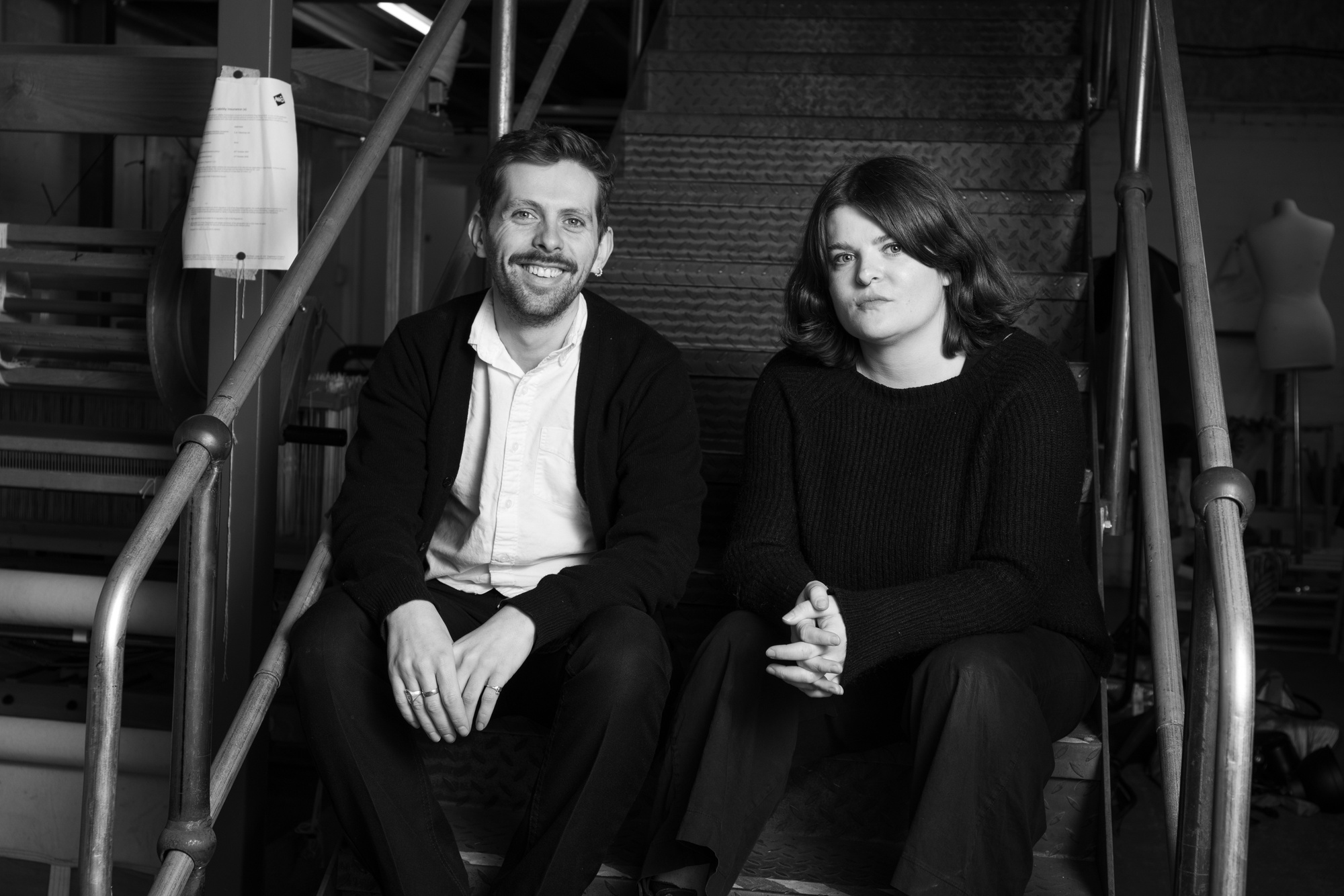
In Conversation With: The Creators of STUDIO FLOOR
Saturday 29 April, 2023 (12.30pm for 1pm start)
Location: The Pyramid at Anderston, Glasgow
Join us for a Live Conversation with Christopher McEvoy & Siobhan McKenna, the creators behind STUDIO FLOOR. The discussion will be chaired by Circular Economy Expert, Lynn Wilson.
STUDIO FLOOR IS THE COLLABOARTION OF CHRISTOPHER MCEVOY & SIOBHAN MCKENNA, EXPLORING COUTURE MAKING & CRAFT TECHNIQUES IN WASTE REDUCTION.
Follow along as we develop a unique range of pieces, made from & inspired by the scraps on each others studio floor, creating a roadmap for other creatives for collaboration & sustainability.
MEET THE TEAM BEHIND

Founder of ReJean DenIm
SIOBHAN MCKENNA
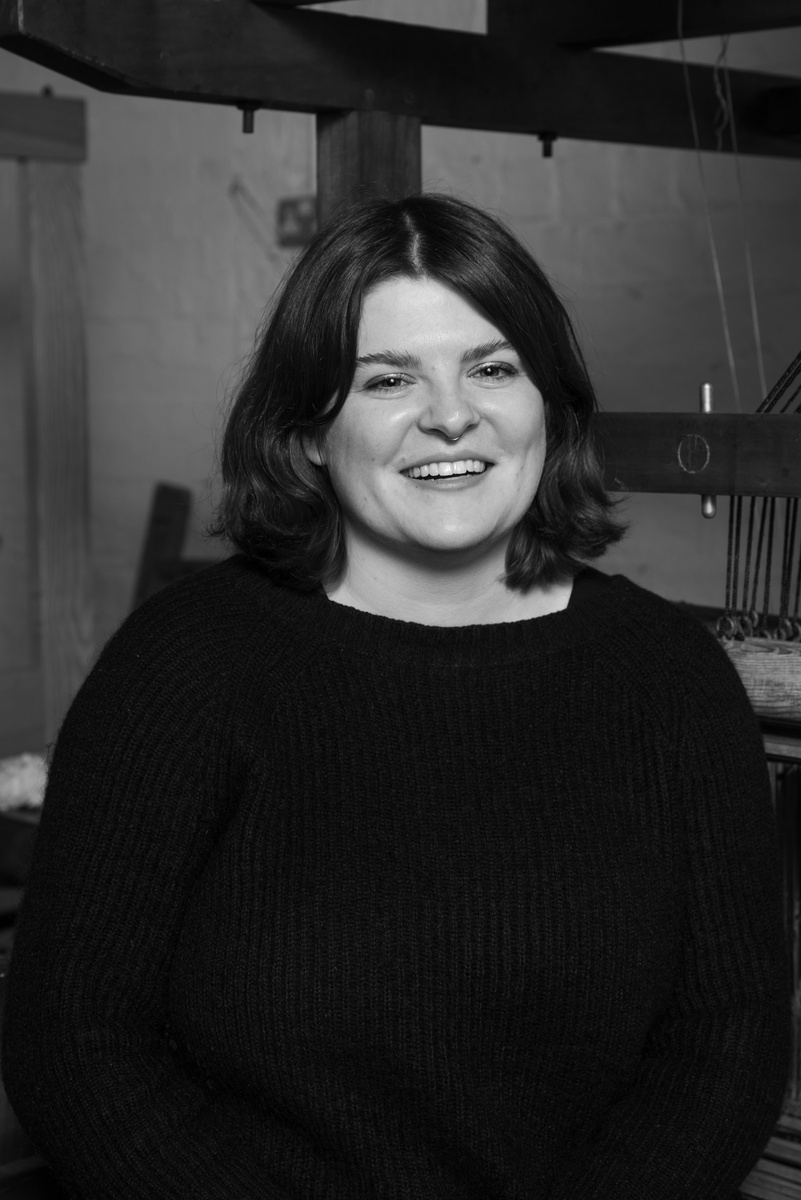
Siobhan McKenna is the founder of ReJean Denim.
Based in Glasgow, ReJean designs and produces denim jackets and accessories inspired by traditional workwear garments.
Each item is hand crafted, using 100% reclaimed denim which Siobhan desconstructs and makes into quality pieces. ReJean champions a sustainable and ethical wardrobe. Siobhan's products save approximately 4KG of denim from landfill per garment and contributes to the tackling of the UK fashion industry's waste problem.
Visible mending is part of the ReJean production process embracing the Japanese 'wabi sabi' aesthetic. ReJean see beauty in imperfections.
Founder of Christopher McEvoy Textiles
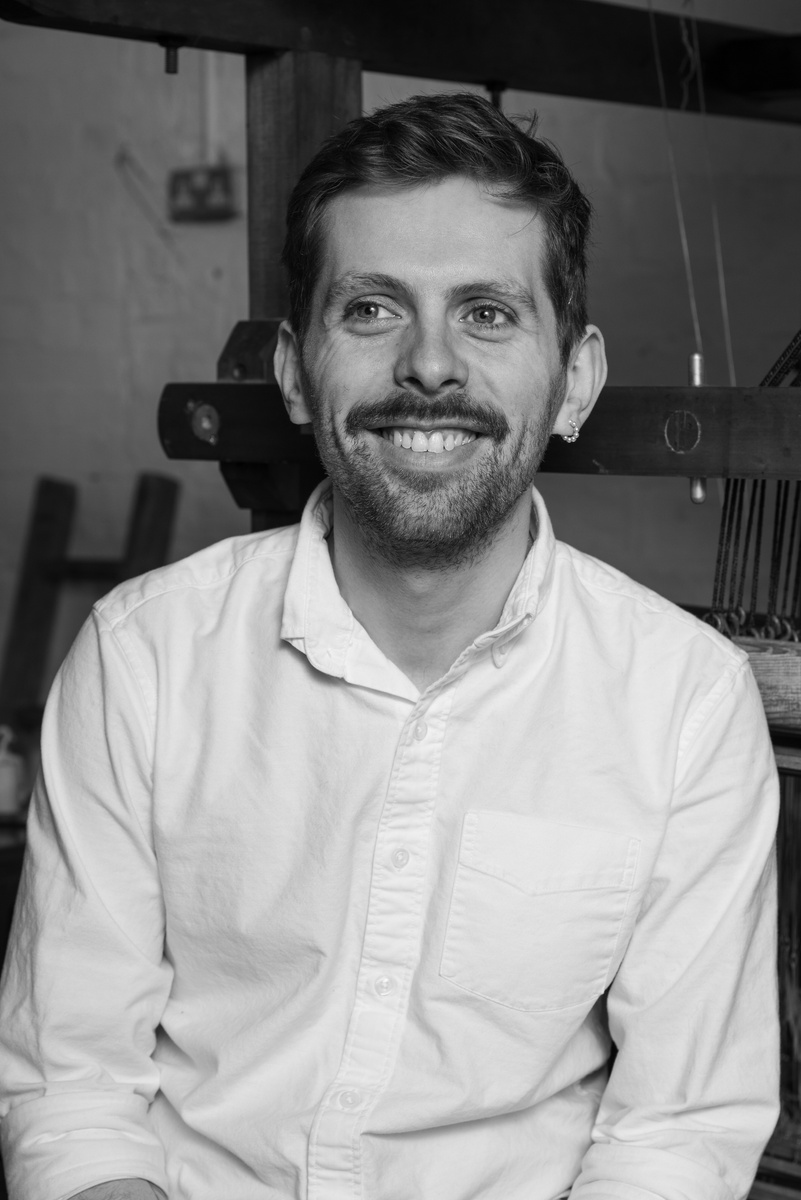
Based in Glasgow, Christopher McEvoy is an award winning weaver working across Art, Design and Innovation. A graduate of Both the Glasgow School of Art and the Royal College of Art London he opened his woven textile studio in 2017. Alongside fellow weaver Chantal Allen in 2020 he set up Vevar, the first micro mill in Glasgow’s East end in over 100 years.
Known for his contemporary takes on traditional Scottish textiles he produces two seasonal collections for the fashion market each year. With an emphasis on unique materials, interesting structures and innovative finishes his work has spanned all levels of the fashion market from the high street to Couture.
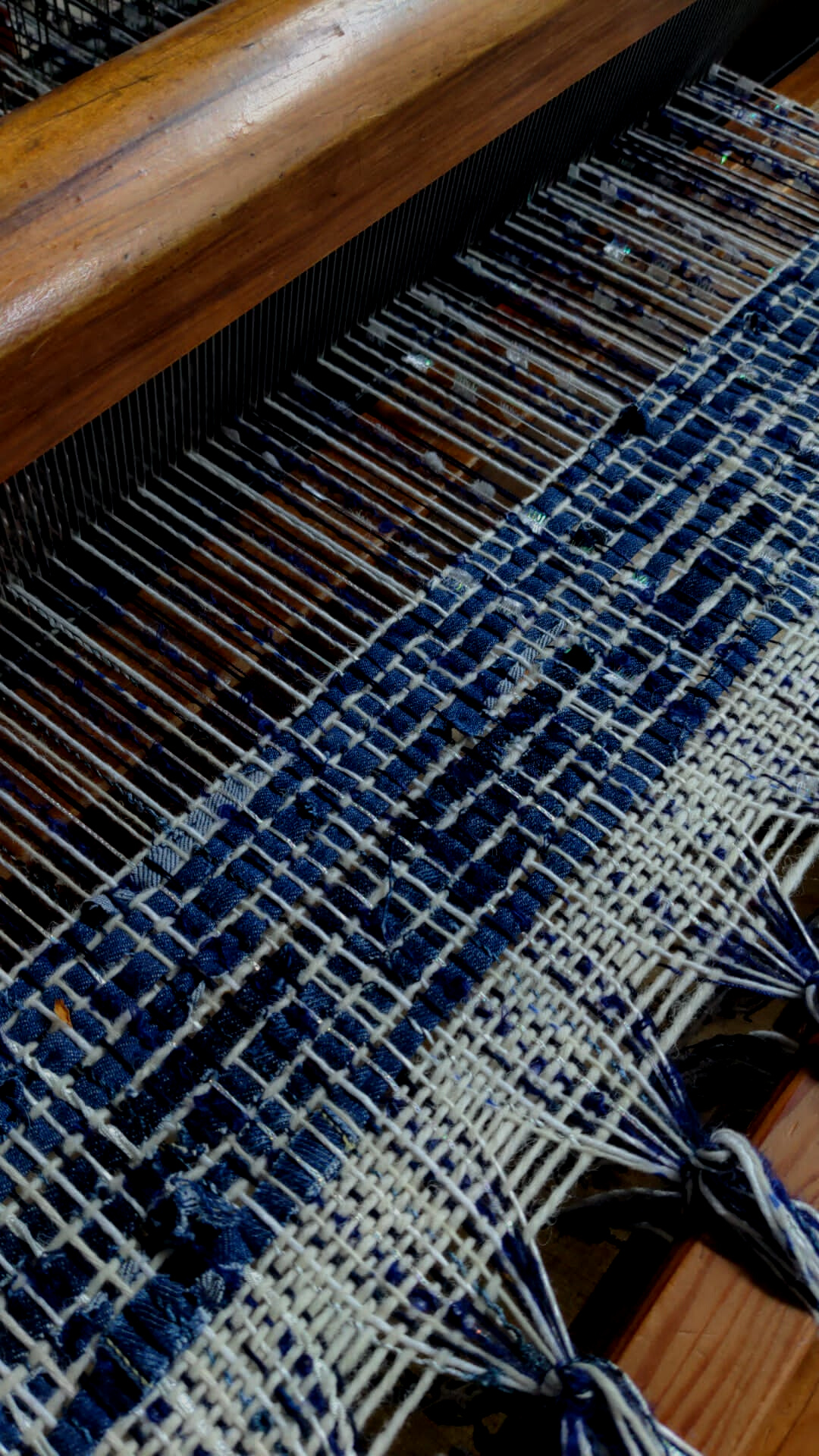
PART 1
WHAT A WASTE
"When discussing the topic of waste in a world that is headed for climate disaster, it is vital that we look at waste differently. Maybe we even rename it, as the connotations of waste are negative. Changing our language could help us get out of the mess we are in, and help us promote circularity within the fashion industry."
SIOBHAN
Studio Floor is a creative conversation between two studios, reimagining what is seen as waste and creating luxury goods whilst celebrating the skills, craftsmanship and design capabilities of ReJean and Christopher McEvoy.
Studio Floor will bring fresh eyes to the waste created by two fashion and textiles studios and reimagining these into new garments/textiles that can facilitate a much-needed conversation around fashion waste and its impact on the climate.
As we enter the Anthropocene man's impact on the world around us becomes more and more evident. The fashion and textiles industry is one of the largest polluters globally.
Approximately 144 million tonnes of textile waste is generated per year by the fashion industry alone.
Post COP26 it has become even more evident that we have to take responsibility for our role in this and the impact this is currently having. It is vital that we as a society shift rapidly towards a circular economy, as individual studios, we are incredibly waste-conscious and we wish to celebrate and share this with as many people as possible to help raise awareness and understanding of this much needed societal shift.
SIOBHAN'S WASTE
‘Hey Siobhan. What does waste look like in your studio?’
Siobhan: Waste looks like tonnes of cut up jeans, pockets, waistbands, beltloops and button & zip flys.
At ReJean we take apart post consumer denim in the form of full pairs of jeans. So we are left with the leftover remnant fabric and rough fabric off cuts.
We also have a lot of thread that we pull out of the jeans as we dismantle them.
'How do you usually deal with studio waste?’
Siobhan: Well, I hoard it. The Studio Floor project has allowed me to reuse a huge chunk of it. I actually sell waistbands and pockets on Etsy. Whatever I am left with after Studio Floor I plan to send on to a recycling company that will essentially shred my waste down and turn it into insulation or something else which is useful.
‘What excites you about using Christopher’s waste from his studio?’
Siobhan: I haven't worked with exciting luxury woven fabrics since university really, apart from the old costume job or bespoke commission.
Christopher has created the first Micro Mill in Glasgow's East End alongside Chantal and it's the first one in over 100 years. It's so exciting to have them just around the corner.
Studio Floor has allowed me to be creative in a new way and as part of joint project. It’s so nice to have the pressure shared amongst two people for a change. I’m excited to change how people think about waste and see how far we can run with the Studio Floor roadmap!
CHRISTOPHER'S WASTE
‘Hey Christopher. What does waste look like in your studio?’
Christopher: Waste in my studio takes a few different forms, there's production waste and design samples from previous seasons that haven't sold or never made the final collection.
Production waste is mainly part cones of yarn, too little to weave with the regularity that industry needs but too much to bin in any good conscious.
With the past samples it's a little harder to quantify. We normally create between 100-200 designs a year and carry many over from previous seasons. However every now and again you need a cull and for me that's if something hasn't sold for 4 seasons. Styles change and there's no point lugging around thousands of out of date fabric and material trends
‘How do you usually deal with studio waste?’
Christopher: I give it away to home knitters etc, at least for the part cones. My mum has been on the receiving end of quite a few bits and bobs over the years...
There's a dog kicking about Glasgow right now with a cashmere crochet pet blanket, which is why I've not been giving away the expensive stuff recently!
The samples are more challenging to deal with as they just mount up and I can't throw them out. That's why studio floor came about, I'd been admiring Siobhan's work for ages and thought if there's anyone who can do justice to our waste it was her.
‘What excites you about using Siobhan’s waste from her studio?’
Christopher: The challenge!
I'm very lucky in my job that I get to work creatively all the time and hop from project to project but I feel there's nothing more exciting than a limit to what you are allowed to use to really challenge that creativity.
I've never worked with denim before really! Silk, cashmere, gold, beetle wings...but this is new for me and that is exciting.
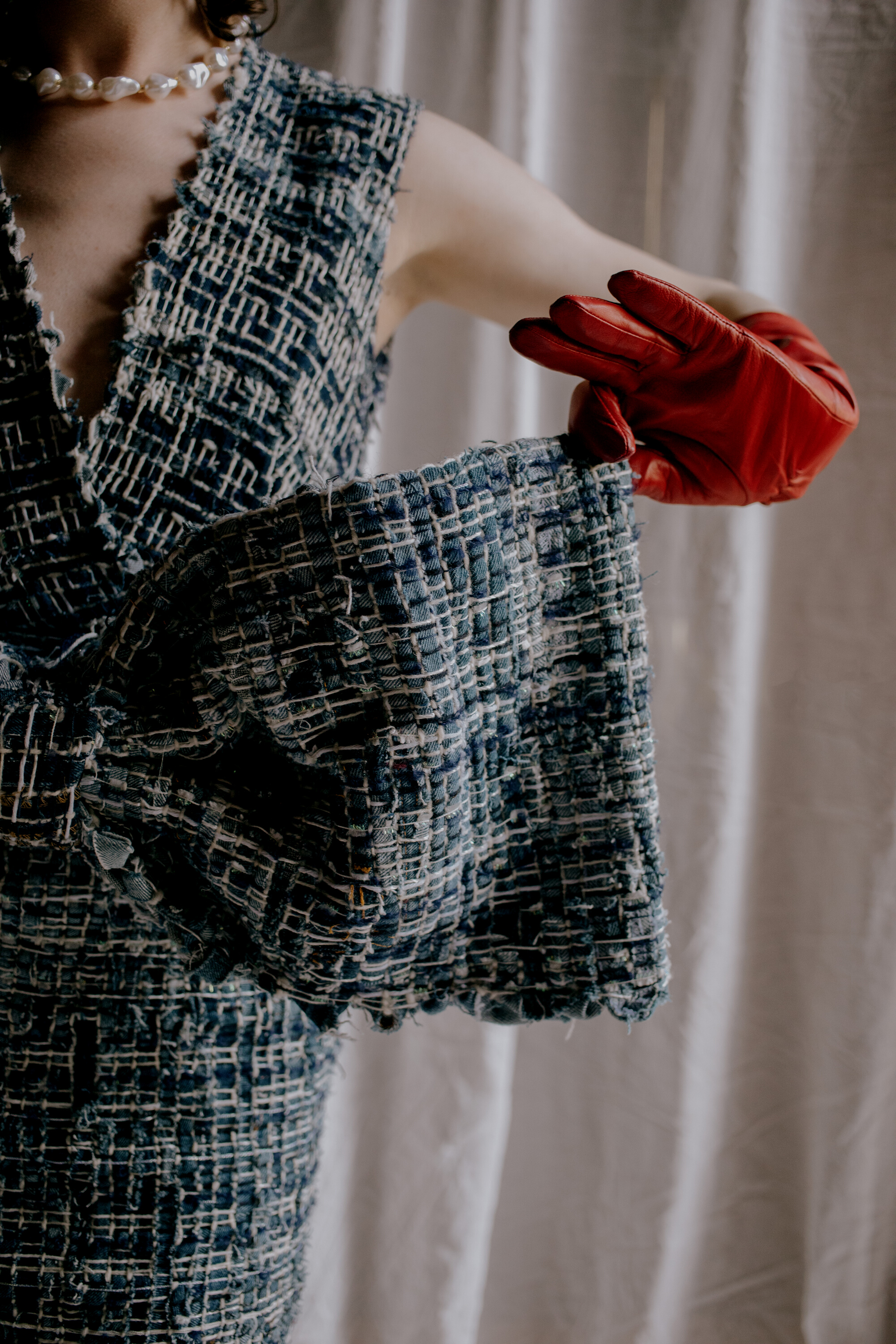
CREATIVE COLLABOARTION
CREATING A CIRCULAR, COUTURE COLLECTION
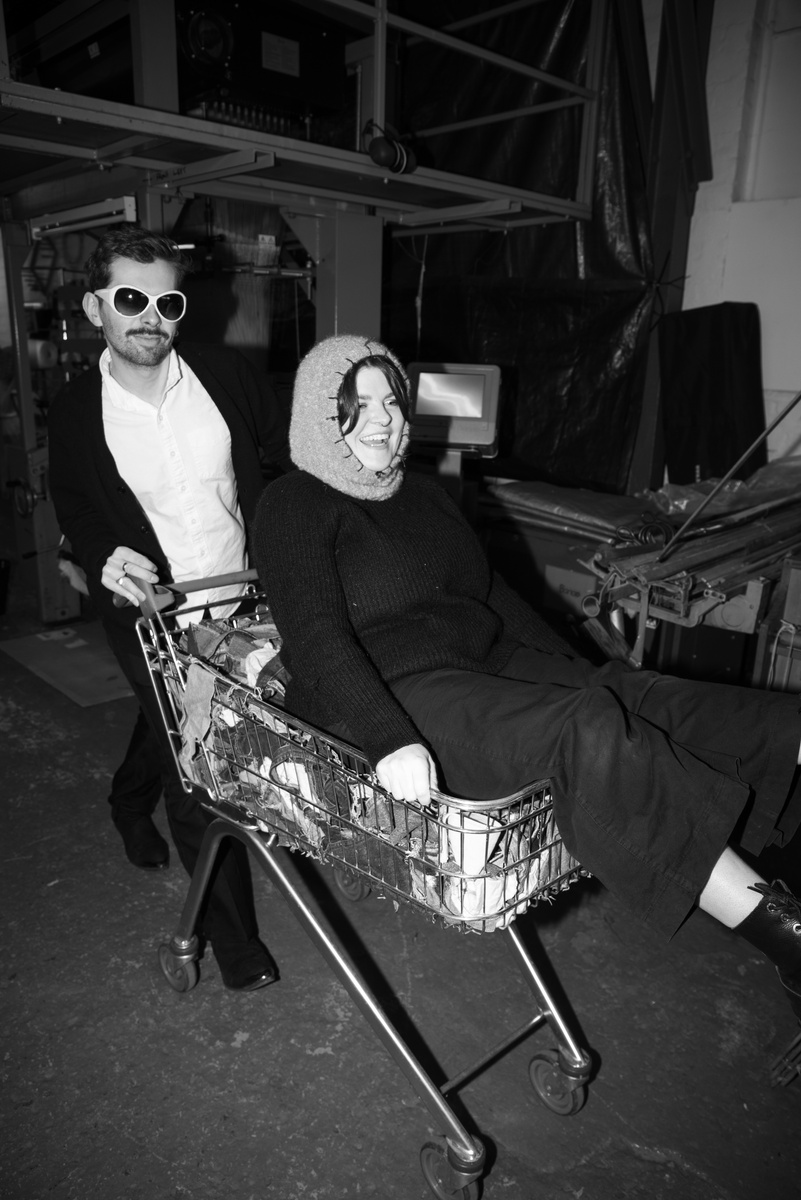
LET'S TALK ABOUT CREATIVE COLLABORATION
Why does the success of STUDIO FLOOR require collaboration?
Christopher: We all get stuck in our little bubbles, and it's hard to see what you are missing because, well, you are missing it! When you go to college or art school or the like you have crits and tutorials where your tutors and peers discuss your work and help you see the angle that you missed. Out in the world, that becomes harder because most often you are by yourself. Feedback and fresh eyes are so important to not only developing new work but also your own. When we first decided to do STUDIO FLOOR it was because we both could see waste in our process but couldn't figure out how to fix it or to see the value in the objects wasted.
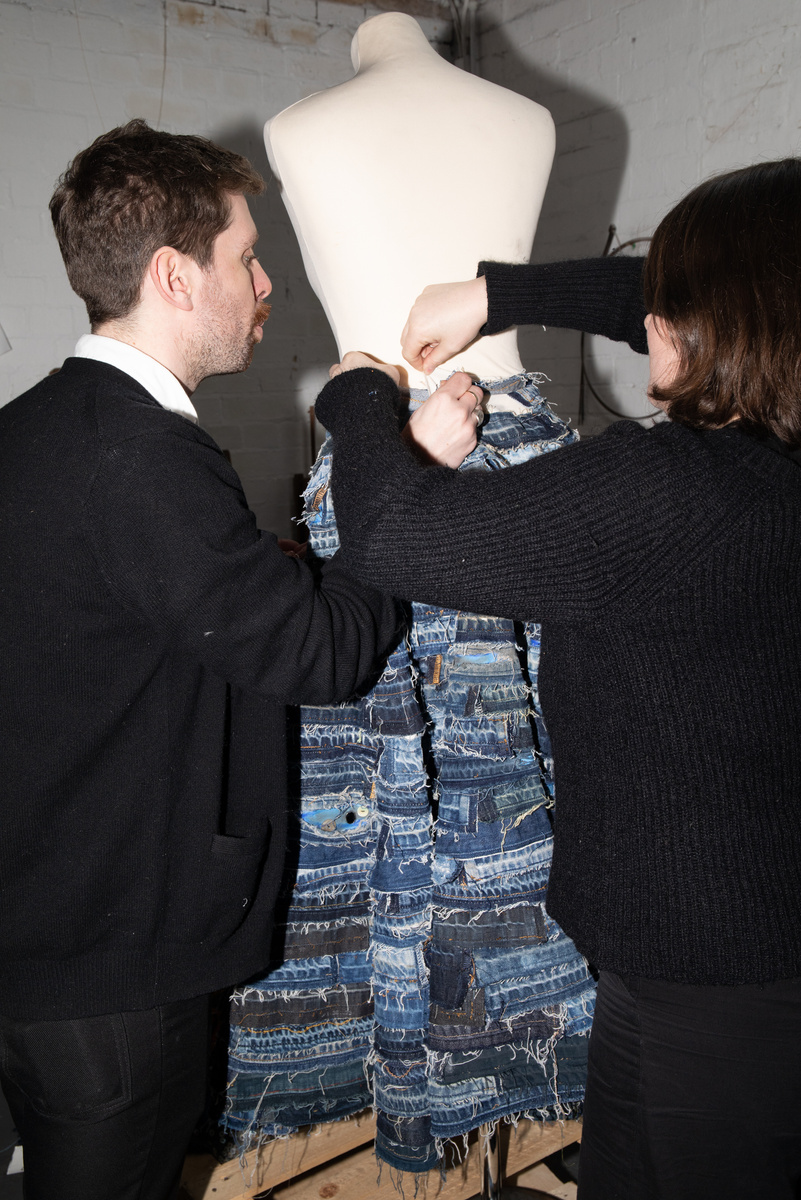
Siobhan: Studio Floor was a collaborative project from day dot, it was born out of a pre-pandemic conversation with Chris, our first ever meeting in fact! The conversation resulted in this huge project that is now coming to the end, which we are both incredibly proud of. It highlights the positives of collaboration. When I’m working solo, I often get too close to the my pieces, so it’s great to have Chris’ fresh eyes.
When discussing the topic of waste in a world that is headed for climate disaster, it is vital that we look at waste differently. Maybe we even rename it, as the connotations of waste are negative, changing our language could help us get out of the mess we are in, and help us promote circularity within the fashion industry.
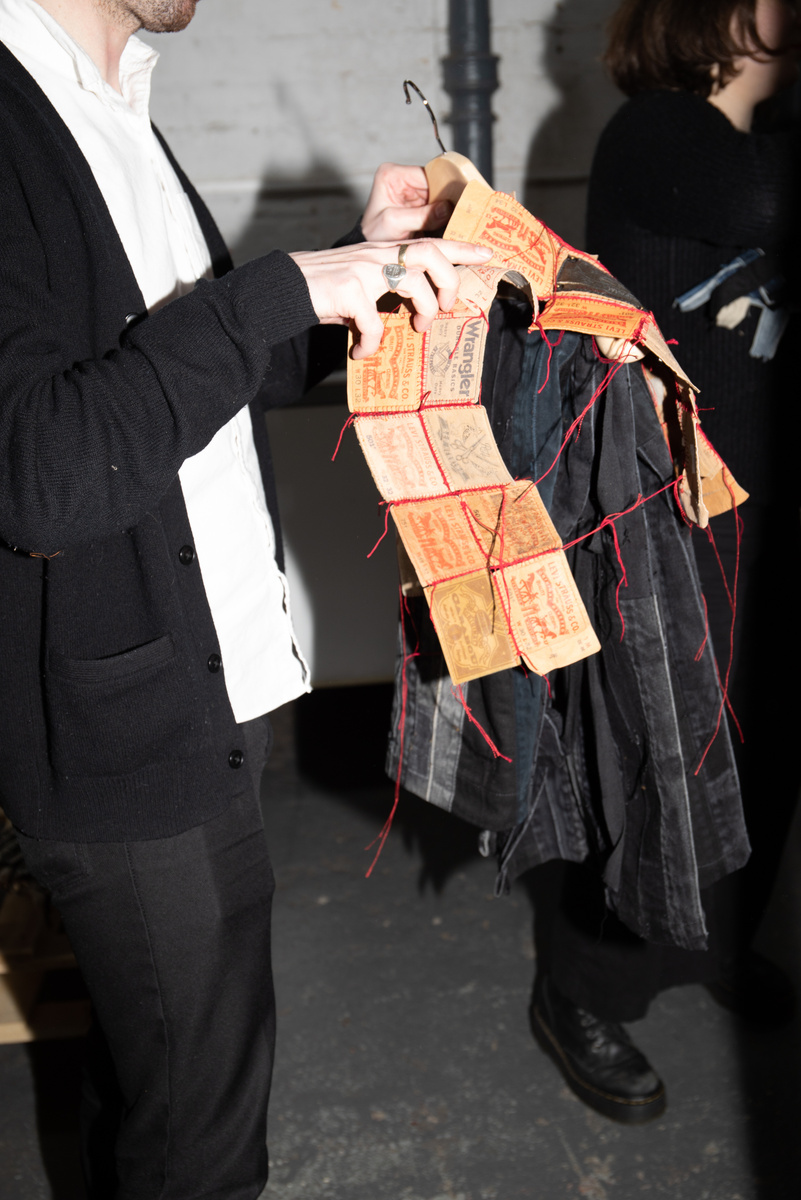
What are the biggest wins/benefits of working collaboratively in the creative field?
C: A win would definitely be hearing a different perspective to your own. We so often get lost in our own work, our own ideas, our own vision that we don’t see the bigger picture, we don't see the wee gem of an idea we have missed! Having someone come in with fresh eyes and ask "have you considered this" is one of the biggest gifts we can get as creatives. It helps take the blinkers off.
S: Collaboration is a massive learning opportunity. We all have our very specific ways of doing things, due to our own learnings and ways of working. Collaboration, if you're open to it, is a huge opportunity to see things differently. And learn specific techniques from your collaborator.
Chris’ creates fabrics but doesn't create garments. In comparison, I create garments form preloved textiles. I work with the cloth ready made. Our practices and learnings overlap, but I think we have both enjoyed and benefited from seeing how the other person works first hand.
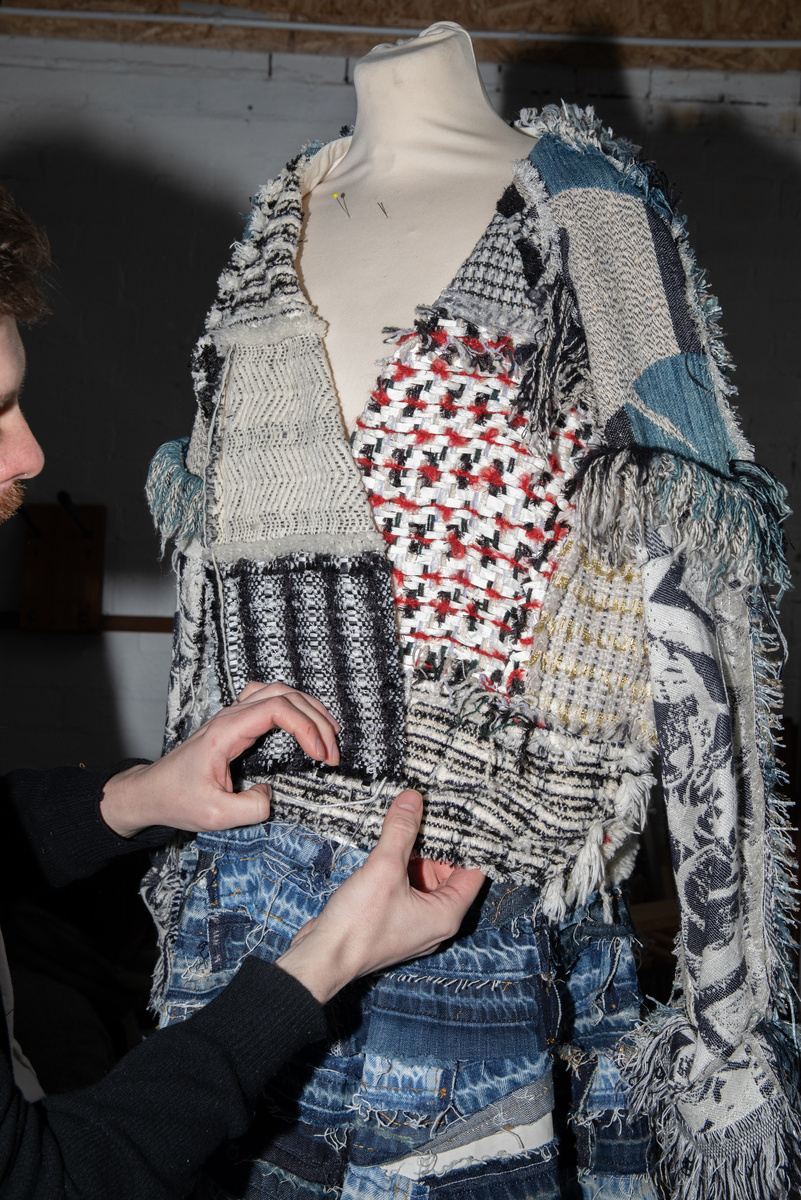
What are the biggest hurdles/challenges to working collaboratively in the creative field?
C: Ego? Which is tough to say out loud/admit as a creative but if you want to be successful you need to leave that stuff at the door. It can be hard having someone commenting on your work/ideas but it's only through criticism we grow. That being said comments/collaboration doesn't necessarily mean criticism, but that's the second challenge you need to learn to overcome and learn to understand: Comment does not equal Criticism!
Take it on board and work with it. It will only make your work stronger!
S: I think a big challenge can be understanding how different people work, especially under pressure. It’s pretty vital information. When undertaking a big project you want to be able to identify each others strengths and weaknesses, and figure how to get the best from each other. Knowing each other’s tendencies and character, who is the realist and who is the optimist, and find a good harmony.
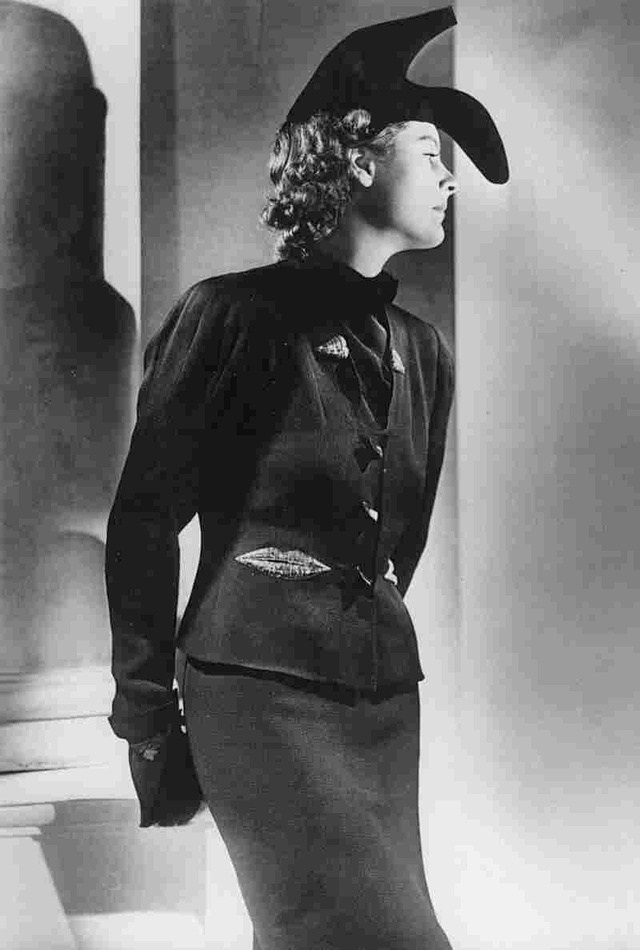
C: Personally I've always loved the way Schiaparelli collaborated. Her shoe hat with Dali is *chefs kiss*. She worked with artists to help forge her own vision. She had an idea and knew that to achieve it she had to work with others. Even today with the resurrected house of Schiaparelli we see Daniel Rosenberry almost collaborating with the archives of the house, updating and reinventing the houses signatures. Which I also think mirrors Daniel Lee's new work at Burberry. It isn't one man vision it's a collaboration with heritage. The wheel doesn't need reinvented, but it can always do with a lick of paint.
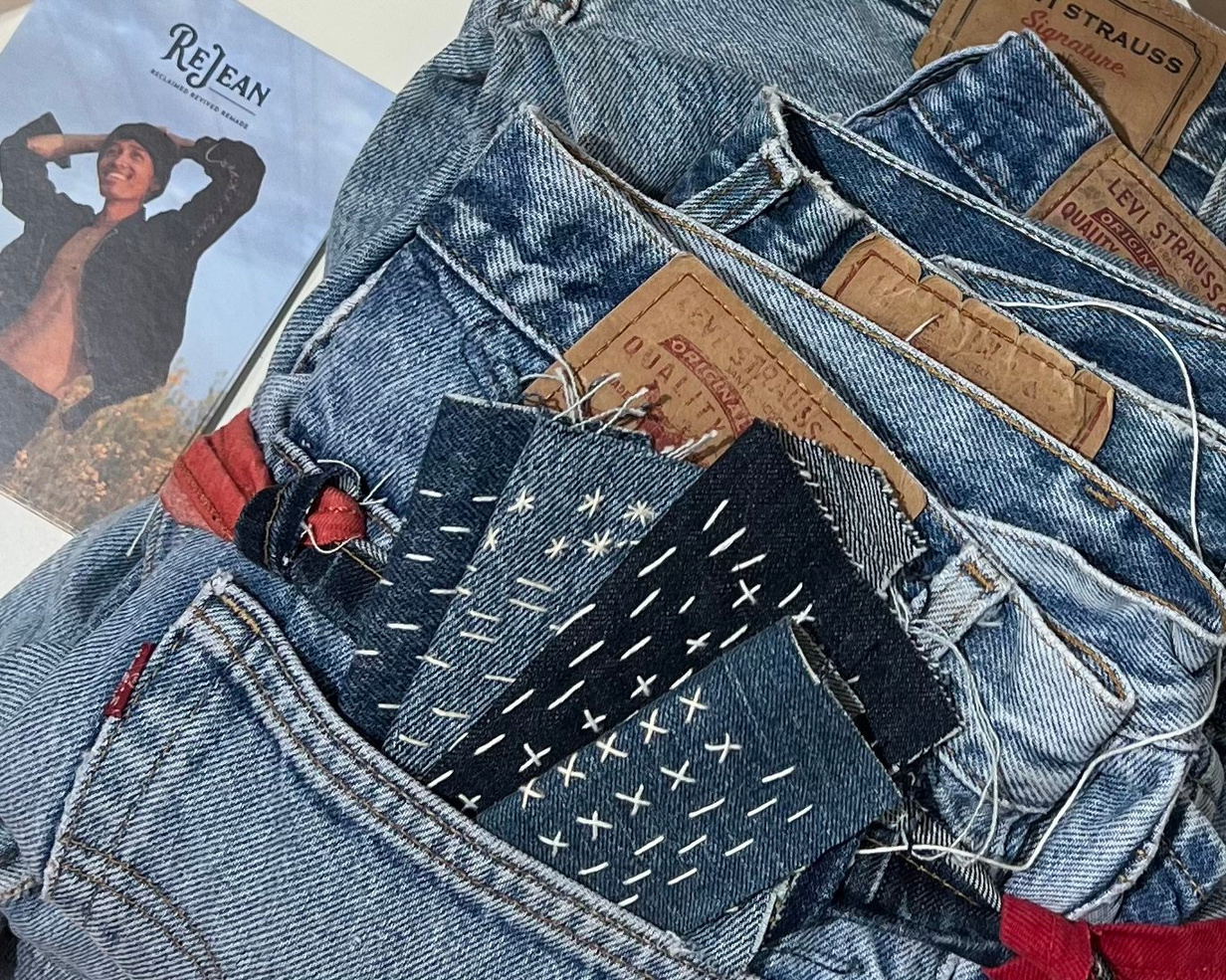
S: For me I take a so much inspiration from Japanese Sashiko & Boro. Given our project is based around working with waste , It ties in very well. Boro means to patch and sashiko means ‘little stab’ as in a stitch, and are the terms used to describe repairing cloth or old garments. Its a huge culture in Japan originally but now its worldwide. These garments are literally wearable art with THOUSANDS of hours of work gone into them, often with many different peoples hands. I see these as collaborations. The life of a garment being repaired by its owner, it then moves onto a new owner who repairs, thus collaborating with the previous owner. Sashiko is essentially a functional embroidery stitch, it adds detail and strength, and features through the Studio Floor collection.
Sashiko artists that I really admire are Rifatto & Pey from Sashiko Denim and Silentwave Indigo.
ACHIEVING CIRCULAR FASHION
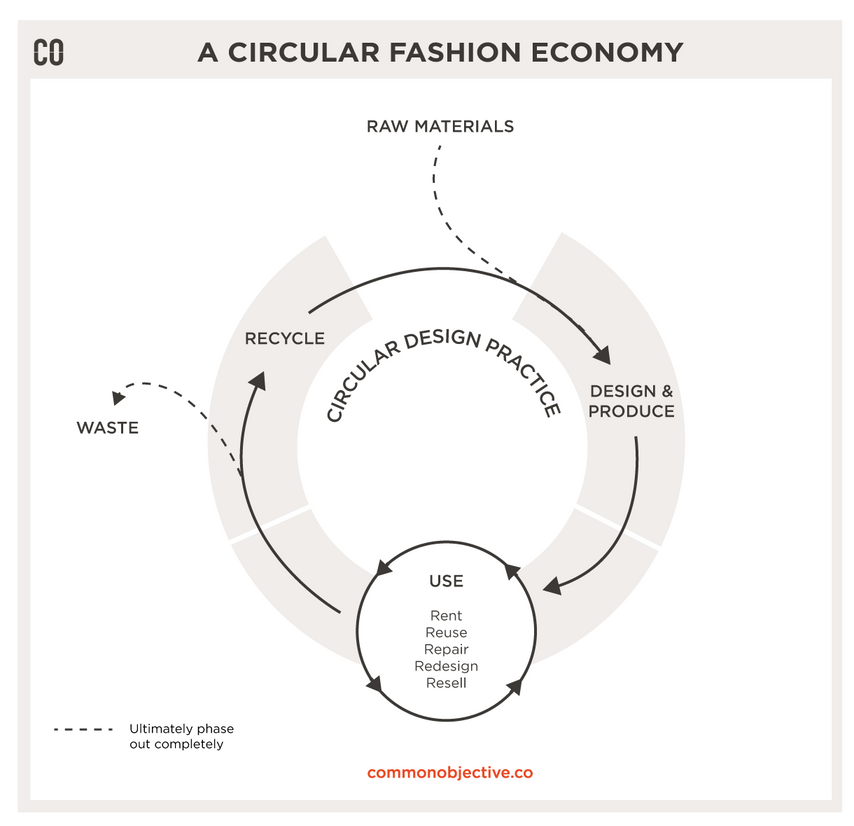
WHAT IS CIRCULAR FASHION?
Circular fashion or a circular system is just the process of keeping materials, textiles or garments in circulation. Rather than the current ‘linear’ system where we buy, use and then bin/replace.
Circular systems are necessary in order to tackle the climate emergency.
Circular fashion is really just the practice of creating garments from textiles that are already in circulation. That’s what I try to do at ReJean. I create clothing form unwanted textiles/garments that are already in circulation. Remkaing them into something ‘new’
The hard part is to challenge the term NEW?
Working with 2nd hand textiles/garments is a time consuming process. The price of materials might be very cheap, or in some cases next to nothing, but you are really paying for the labour. You are paying for the cleaning, sorting, unpicking, remaking of a garment. Often these styles cannot really be ‘mass produced’ as the raw materials will vary greatly. Resulting in one-off pieces. Something special that not everyone has.
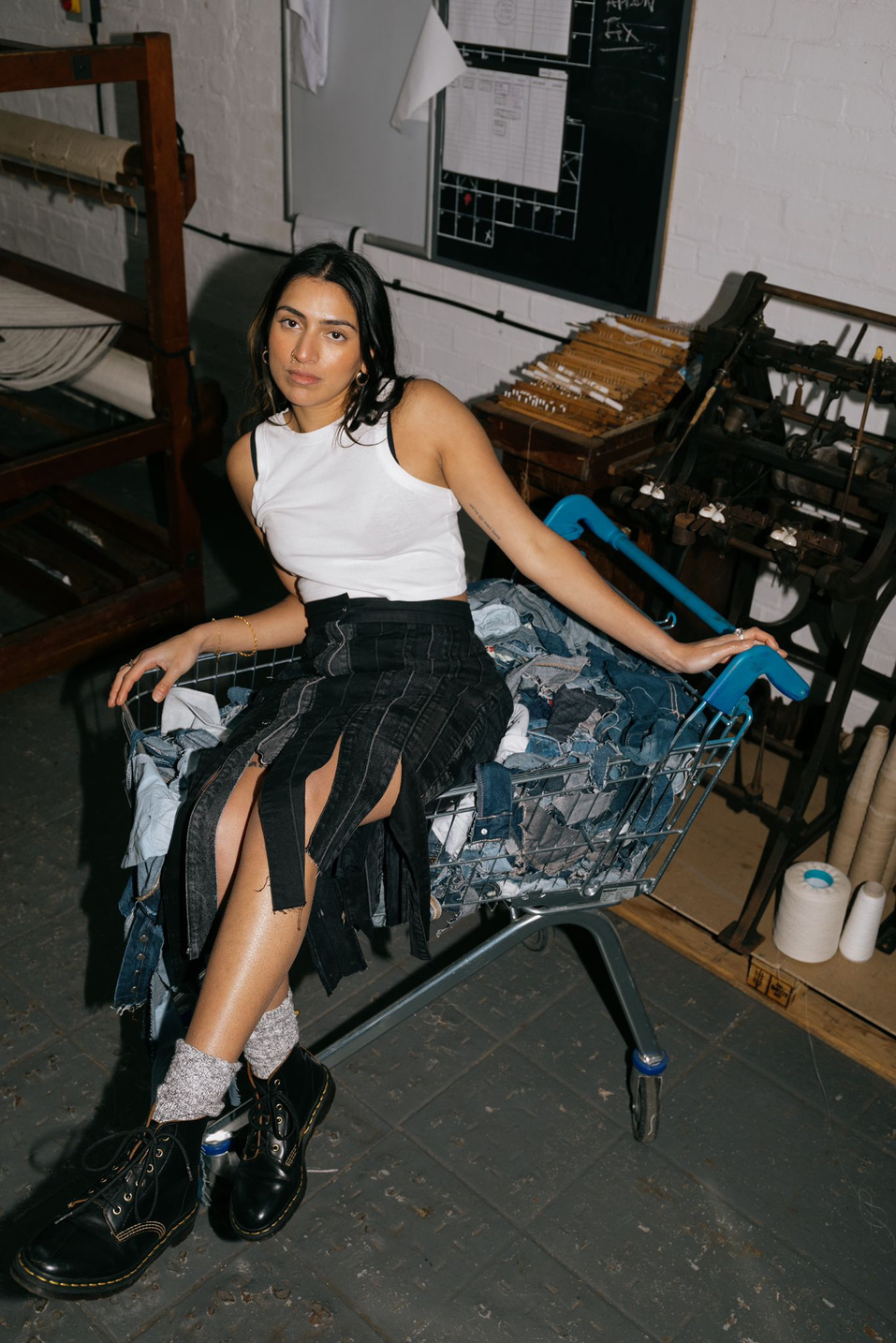
WHAT IS STUDIO FLOOR'S CIRCULAR FASHION MODEL?
For STUDIO FLOOR, we looked at the textiles that we considered waste, essentially what would usually be destined for the bin.
Siobhan had been struggling to use the scrap denim at the rate she was creating it. And so jumped at the opportunity to delve in to a project to use it creatively. For the STUDIO FLOOR project it meant using it alongside really high end woven fabric samples from Christopher.
When working with ReJean denim waste we sorted into colours and ‘pattern pieces’ essentially sorting pockets, waistbands, hems, beltloops and flys and then treated each type of piece like yarn and essentially built a fabric with it .
Each piece you see within the collection has been worked on by many hands, the fabric has been created from scratch or we have embellished natural fibres fabrics with our waste.
We decided to add a woven embellishment theme to the collection. Working with a Houndstooth pattern on different scales across key pieces within the collection.
The circular couture element of the collection acknowledges the multitude of hours that have gone into creating each piece. Every garment has a huge amount of hand stitch detailing.
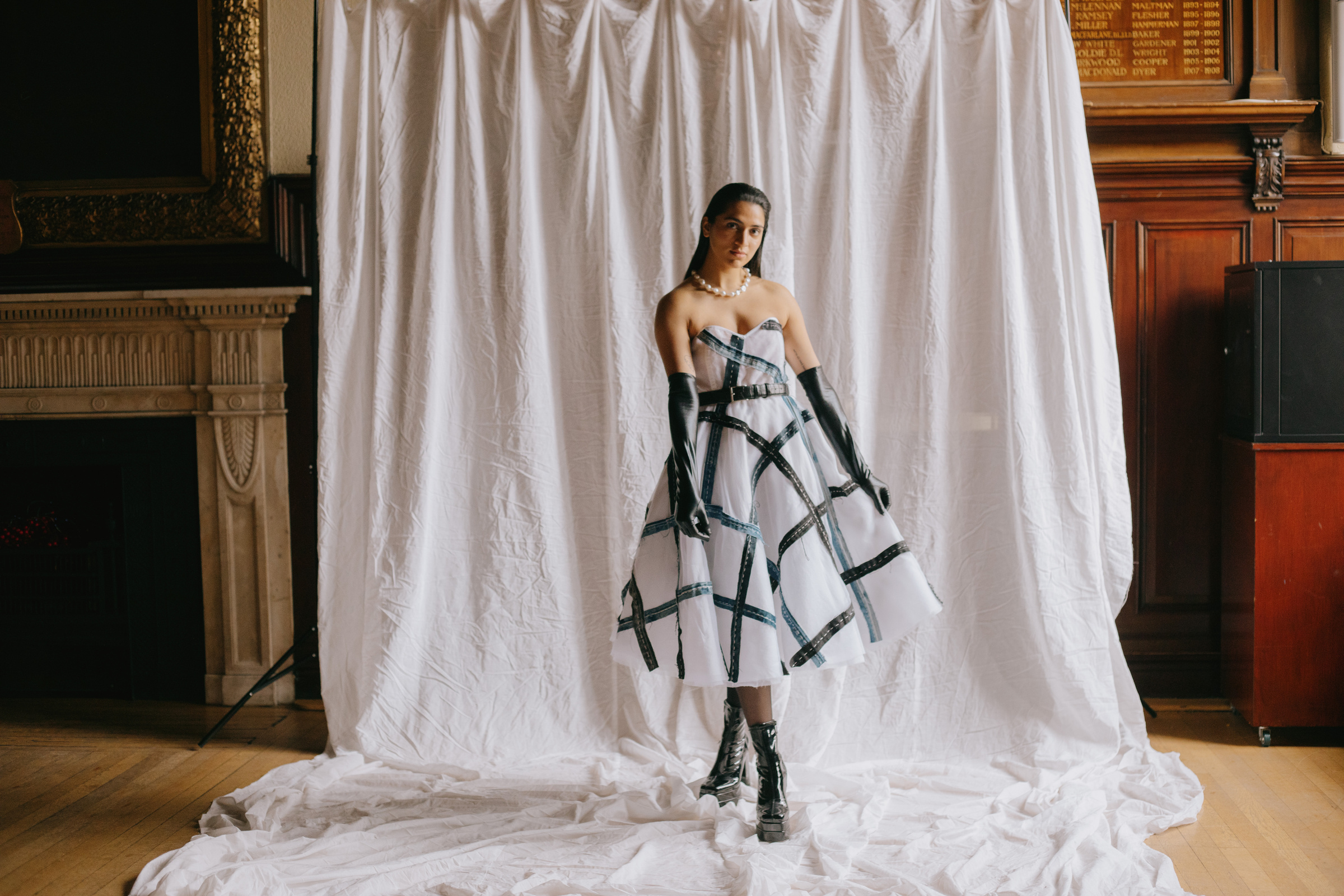
MAKING
CIRCULAR
FASHION
COUTURE
WHAT IS COUTURE FASHION?
Couture fashion has a very strict definition and it is regulated by the "Fédération Française de la Couture" and is all very official. To learn about the exact definition click here.
But for brevity, Couture must be made to measure and exhibit some if not all elements of Savoire Faire.
"Savoire Fair" is "the know how" and in this context the know how of how to put a beautiful garment together. From construction to decoration it must exhibit a skill beyond the ordinary, to use its components in a way that illustrates the skill of the maker. It can't be Pret a porter or "off the rack" it must be as unique as the wearer.
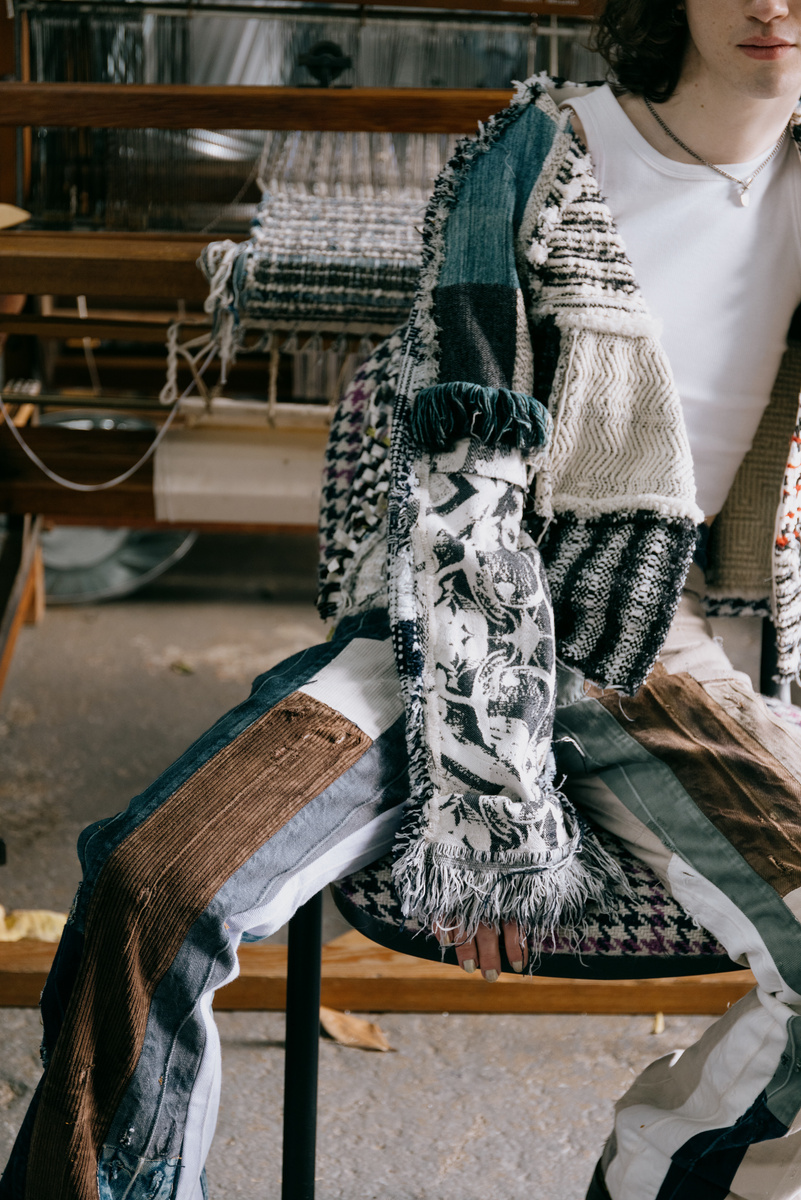
WHAT MAKES STUDIO FLOOR COUTURE?
Couture is made to measure and in most cases unique there will only be one (or two!) Because of the nature of the materials we are using (waste) we can only create one of each piece. They are totally unique and unrepeatable. Studio floor also utilizes Christophers background working in runway and couture to bring in techniques and silhouettes that when combined with Siobhans understanding of denim and workwear create a truly unique collection which envokes not only the spirit of the two studios but couture on the whole.

PART 2
WHAT A WASTE
POST-PROJECT CHAT WITH SIOBHAN
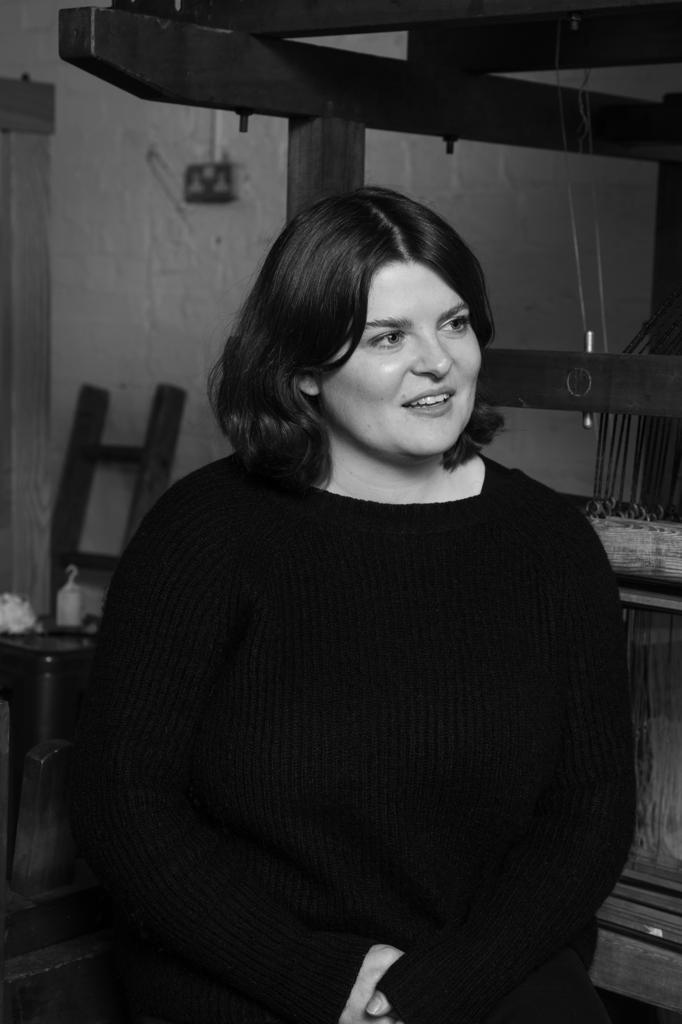
Hey Siobhan! Your company ReJean already uses a circular fashion model - turning old pairs of jeans into amazing new garments. How did you find working with new types of textile waste from Christopher’s studio?
S: It was really exciting and a bit scary at the same time! Some of the fabrics that Chris has wove specifically for STUDIO FLOOR are so exciting to me - they're so intricate and delicate. I had to take a lot more care with these fabrics and It was more nerve wracking to cut into them. When I'm working with with second-hand denim I'm less precious because if something goes wrong its not as big an issue.
I also loved the natural frayed edges of Chris' fabrics and wanted to make a feature of them and I think that tied in really well with the raw denim patchwork already apparent in the collection. I actually had to reign it in on some pieces and stop myself from getting so excited about frayed unfinished edges! When working with Chris’ old samples, I had to work with them completely differently than I would denim. It was refreshing to handle and work with different textiles as I get so used to denim and it is a very easy fabric to work with for the most part.
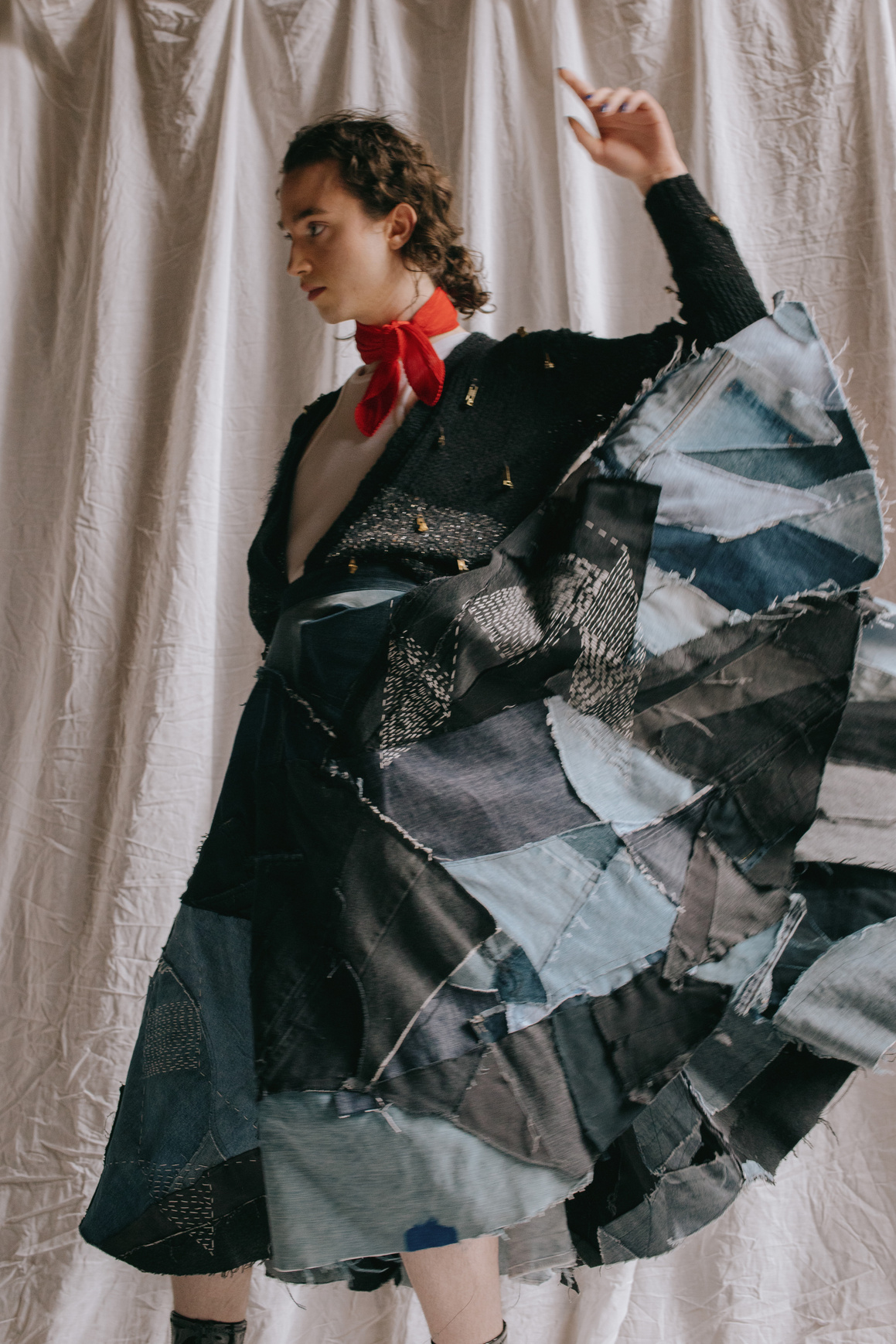
Has there been any new waste reduction techniques you’ve used in Phase 1 of Studio Floor that you’ll adopt for future use in the ReJean studio?
When Chris came up with the simple idea of grouping parts of the jeans and stitching them together to make a fabric i was almost annoyed at how simple it was, my initial thought was 'why haven't I tried this before?!'
Making fabrics from the waistbands was great, as the fabric used to make a waistband is about 4” wide, so we could quickly create a big piece of cloth to cut a garment from. The same applied to the hems and I think this project has led me to value these elements of my studio waste. I can see accessories or some details from the project being reused within ReJean going forward, definitely.
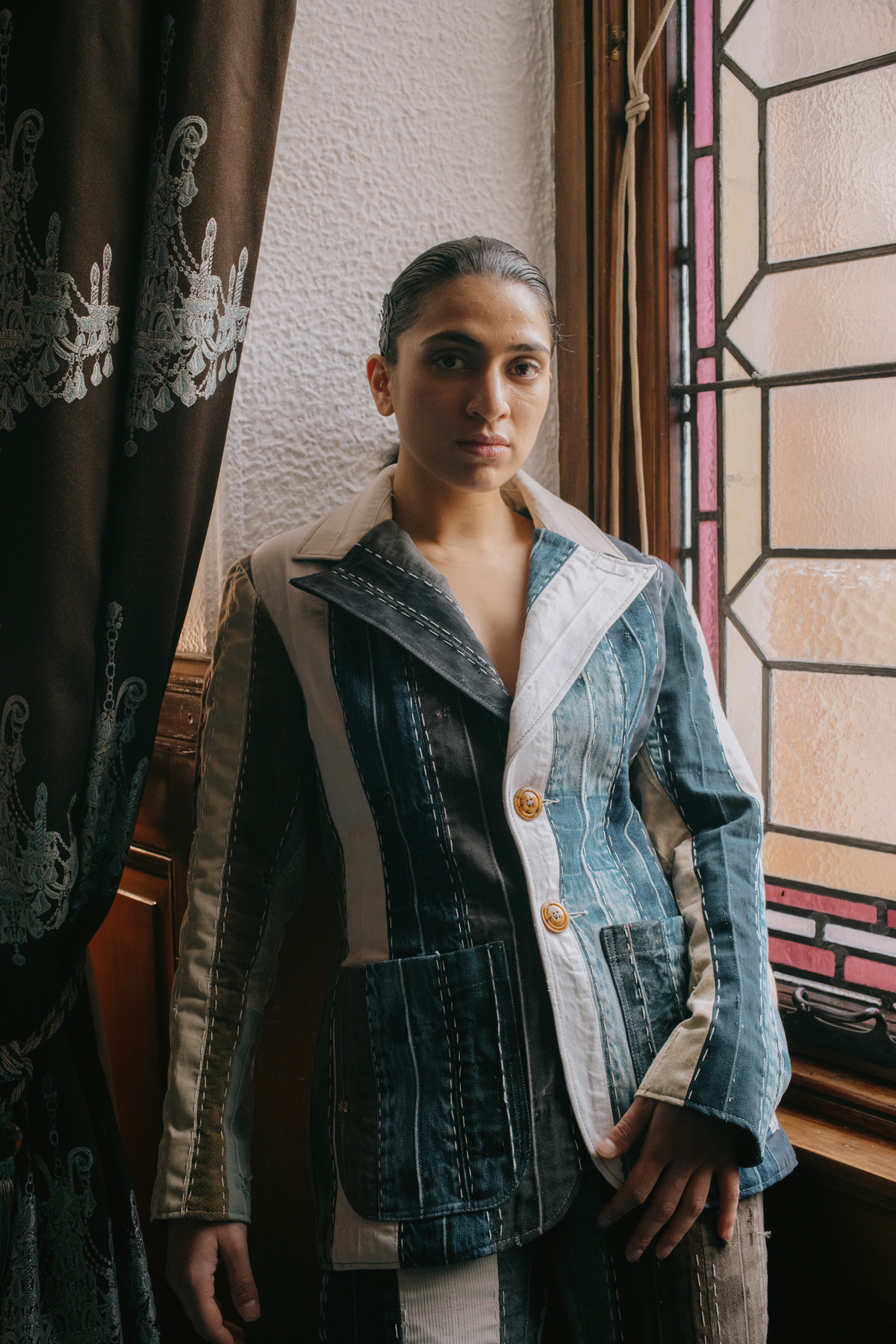
Can you talk us through your favourite technique you’ve used for the Studio Floor collection?
S: I absolutely love handstitch and sahiko and it has been a joy to add this as an embellishment detail throughout the collection. Creating raw patchwork stitched together with sashiko has been a labour of love but a joy to be able to work on a project where we are dedicated to adding this level of detail. Because it's an exhibition and not garments for sale we weren't hindered by price points and wearability, and could just create really beautiful intricate pieces.
Sashiko was used to embellish the white dress with the denim tartan design. The waistband suit really needed the extra detail to lift the construction and the colour palette we created with the waistbands. Our 2 raw patchwork jackets in black and blue, using both denim and chris’ woven fabrics were constructed with sashiko and machine stitch.
The raw patchwork houndstooth skirt features to exaggerated houndstooth stitch using sashiko. It to be honest if we had more time I would of added it to many more garments.
On the day of the Private view i had our wonderful intern from GCU, Jade, adding a few touches to a skirt just before we opened.
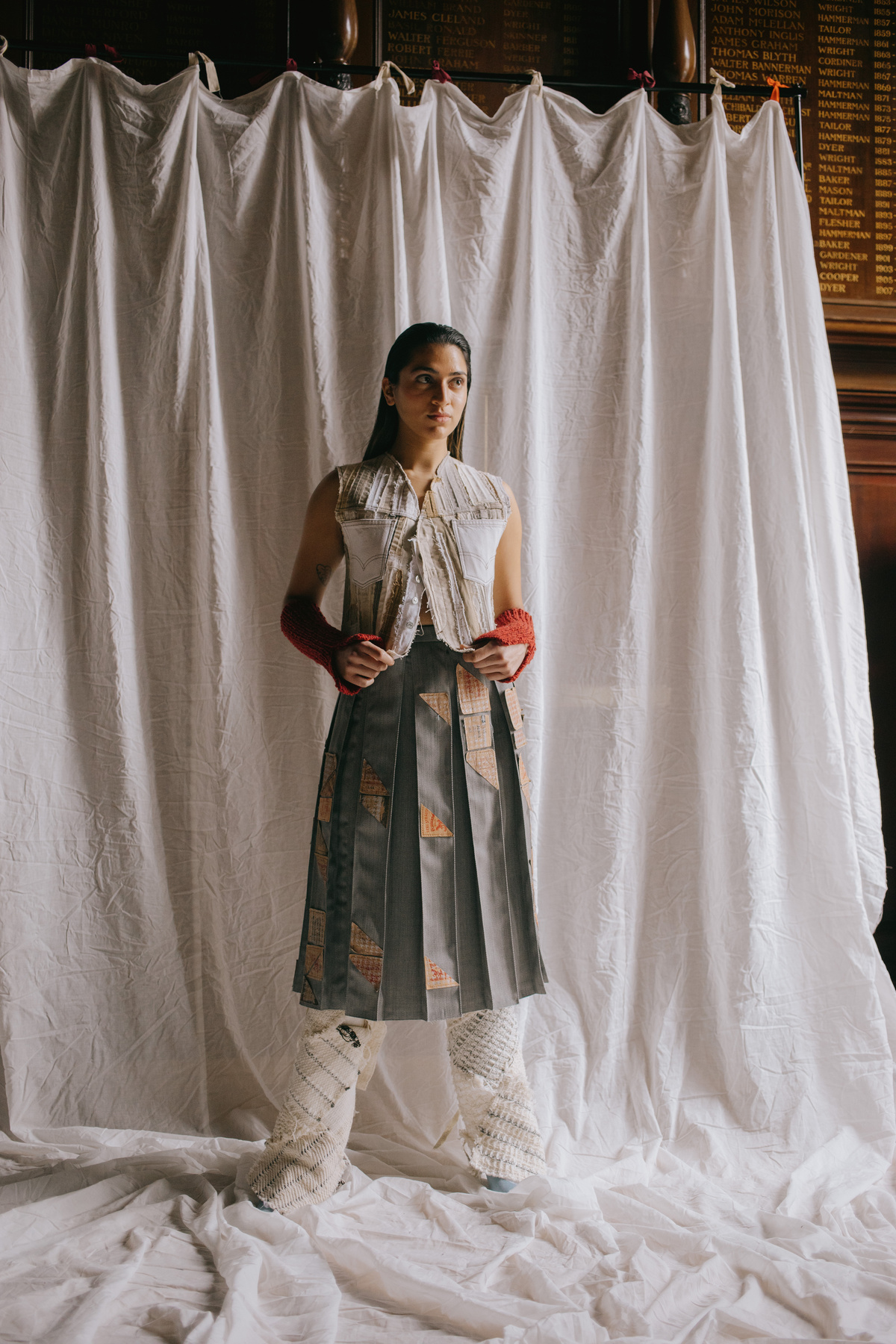
Trial and error is essential for any creative process, right? Are there any waste reduction methods/techniques you’ve tried which haven’t worked how you would have liked?
S: Definitely! We made a bolero jacket from the paper/leather patches usually found on the back of the waistband on a pair of jeans. They were crocheted together by Alex right at the beginning of the project but it needed more refining. Chris didn't think it was clean enough for the final line-up. I would of liked to go back to the piece and refine it, but as it was all handstitched we didn't have time to go back to it. The patches did however feature as an embellishment onf a pleated skirt, in a deconstructed houndstooth applique.
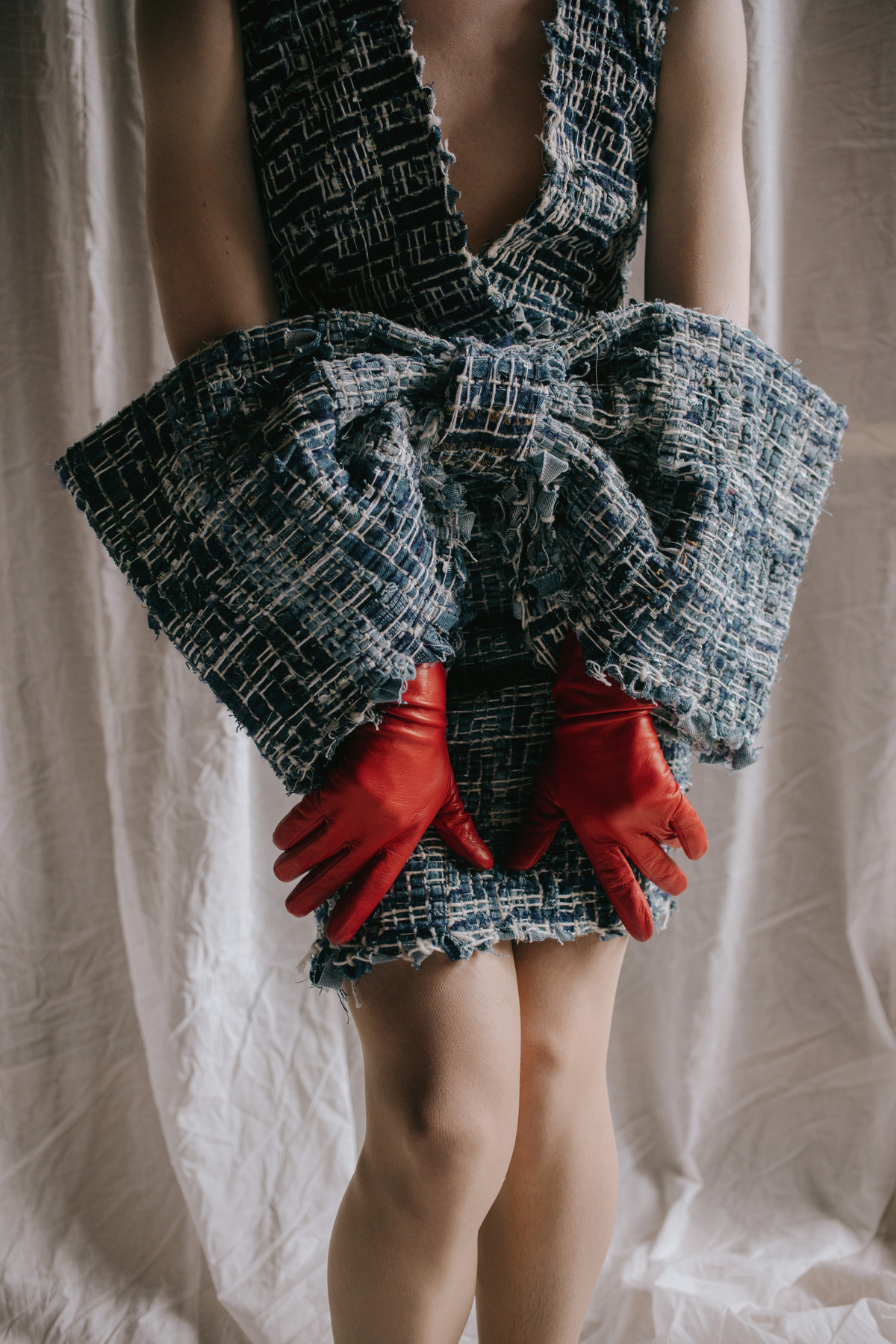
What’s your favourite piece from the Studio Floor collection and why?
S: Oh, there are so many! I really love them all. I think my favourite is the waistband suit, followed closely by the denim tartan dress, but also so many others too. We really could have kept making, and I would love to do it all again, but unfortunately time is a commodity I don't have much of!
Thanks for chatting with us Siobhan!
POST-PROJECT CHAT WITH CHRISTOPHER
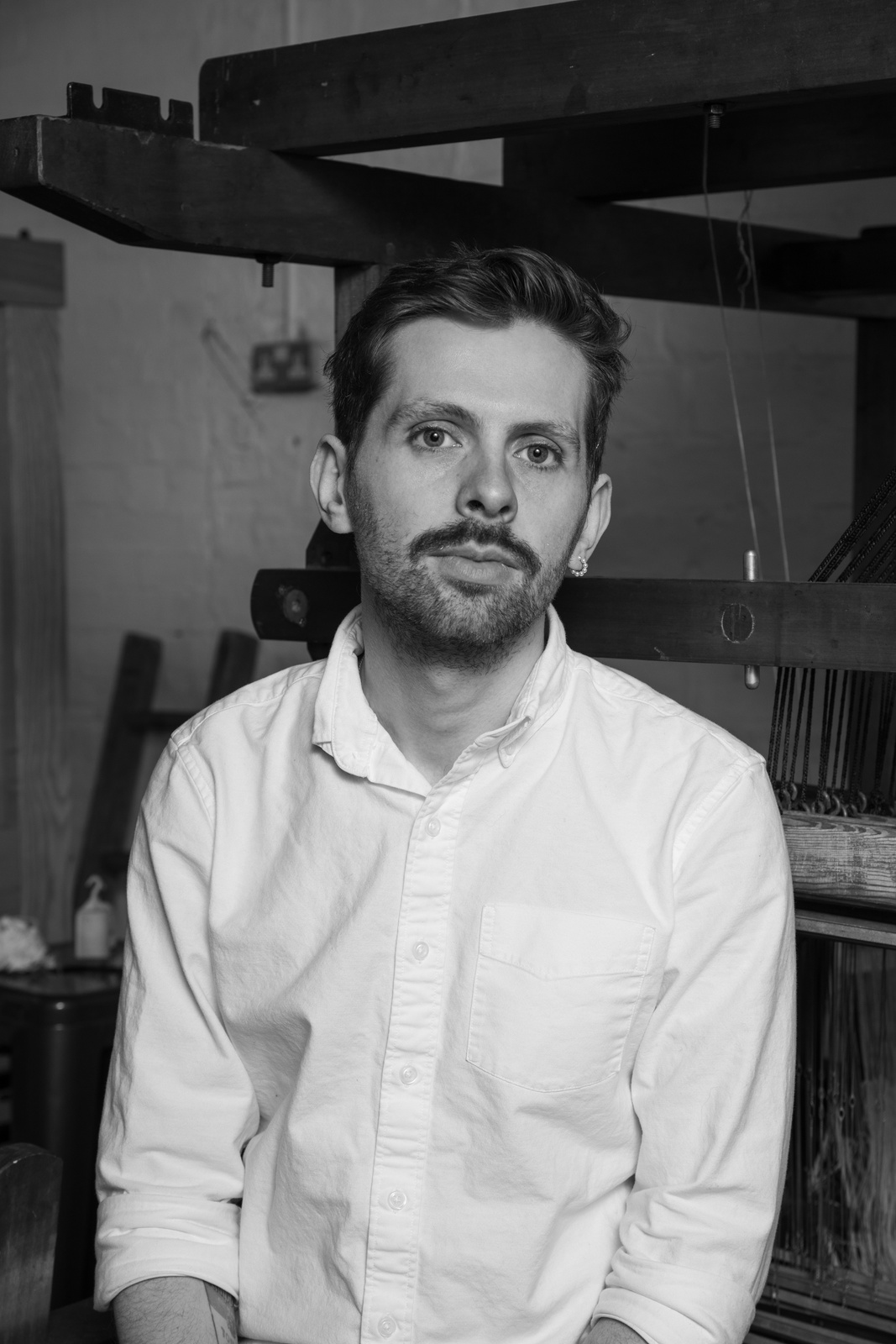
Hey Christopher! You’ve mentioned previously that you haven’t worked with denim much before. How have you found using waste from the ReJean studio?
C: It’s been a challenge! Denim is an interesting material. It has its origins in work wear so has a quality that kind of goes against much of what I’m used to trying to achieve in my fashion fabrics. Throw in that it had to be waste denim and that's a whole other dimension/constraint to an already interesting challenge.

Could you talk us through some of the amazing ways you’ve incorporated denim waste into your weaving concepts?
C: I think the process that to me has been the most couture, and has nestled most closely with my practice is our unpicked denim yarn.
We started taking little scraps and pulling them apart, and knotting the ends together. This created a sort of eyelash yarn, that variegated not only between the different shades of denim but also between the areas of wear within the pieces themselves. I think it's a really interesting yarn and also as a yarn we were able to weave a more traditional fabric with it.
We wove it into a houndstooth (our project's main motif) alongside some metallic viscose to create a panel of very luxurious, textured tweed that in all honesty took FOREVER.
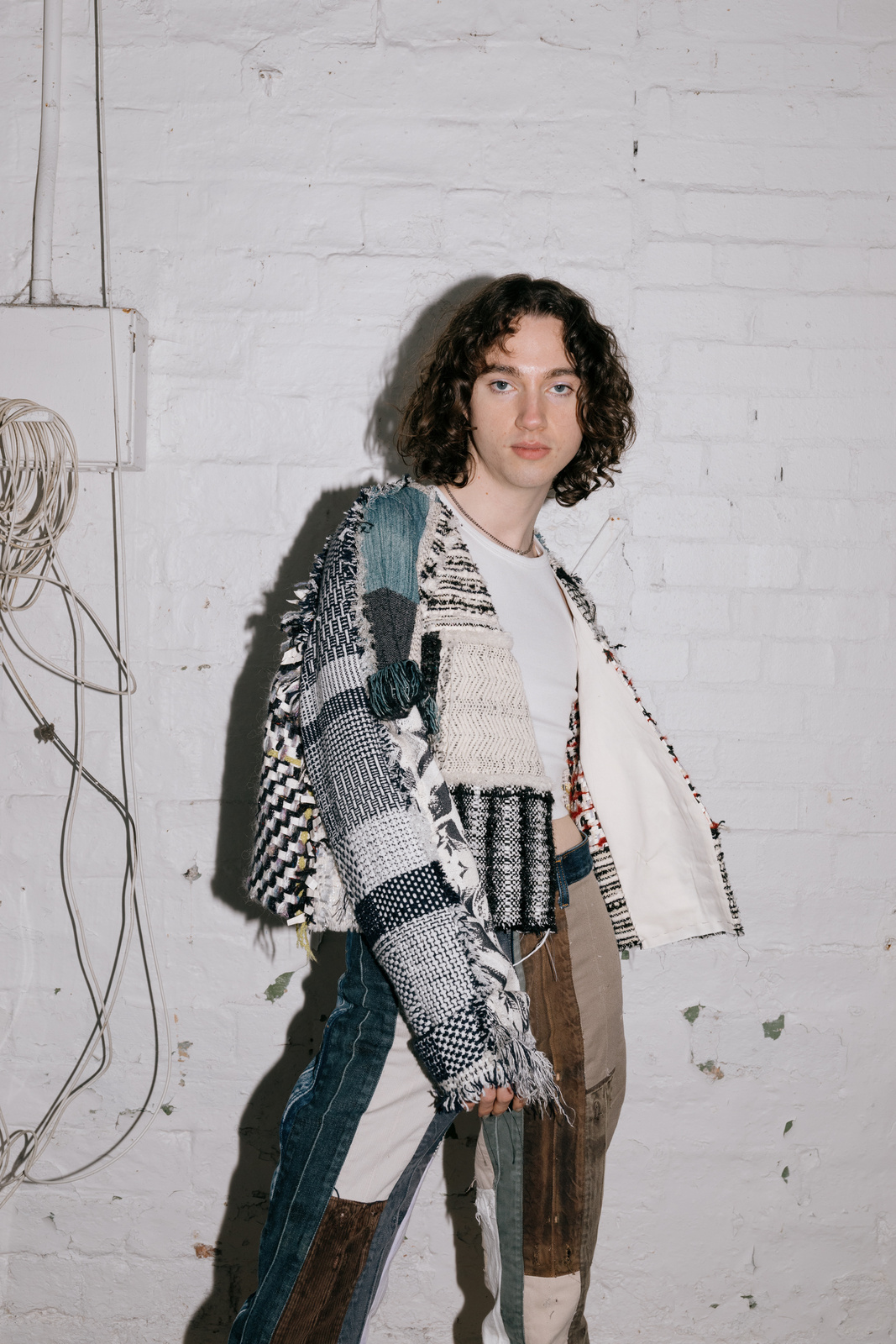
Are there any waste reduction methods/techniques you’ve tried which haven’t worked how you would have liked?
C: I think the weaving with denim could have been more refined. Towards the end of the project and with the final pieces, you can see us getting there - we were cutting the denim thinner and blending it with more wool but at the start the fabrics felt more like rag rugs.
If we had more time i think we could have explored ways of cutting the denim to create much more refined and clean final fabrics.
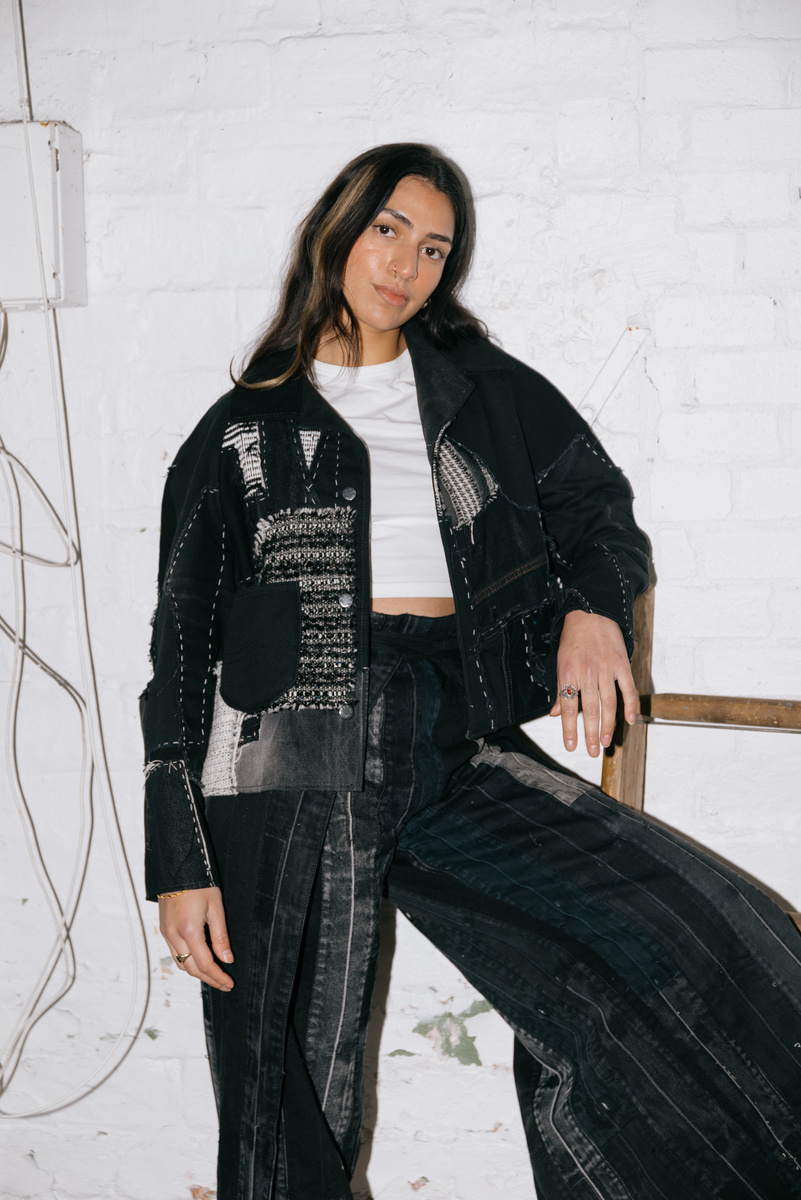
Could you talk us through some of the amazing ways you’ve incorporated denim waste into your weaving concepts?
C: Hate to say this but the unpicked denim yarn! I think its beautiful but takes so long to make. I’m looking forward to trying it with different fabrics and possibly combining it with dismantling printed and painted fabrics.
What’s your favourite piece from the Studio Floor collection and why?
C: It's hard to choose! But I really like seeing my old samples have a life beyond the cupboard of doom where they used to be kept. Looking forward to stealing a jacket for myself.
Thanks for chatting with us Christopher!
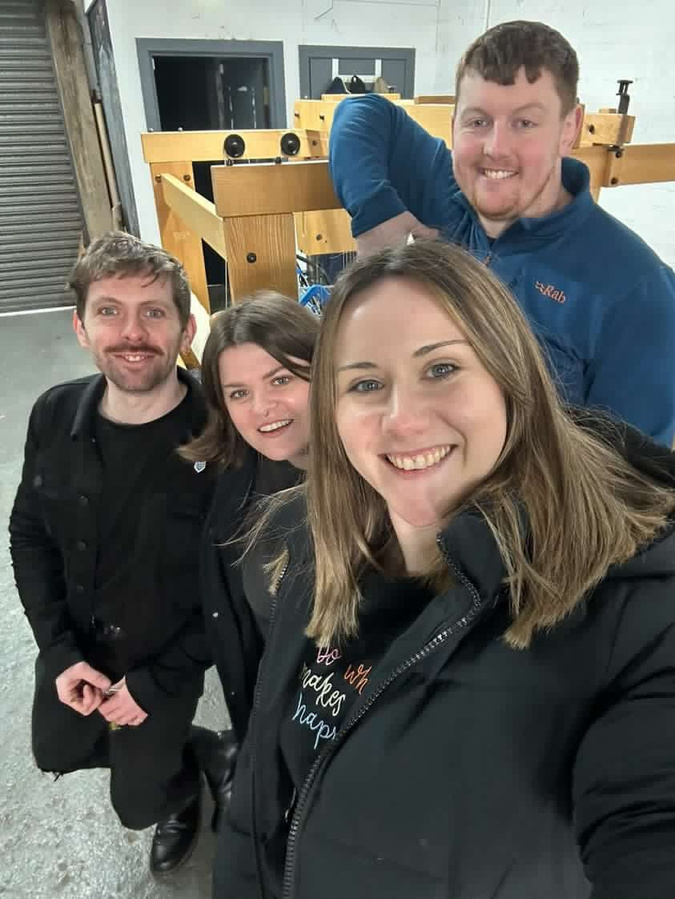
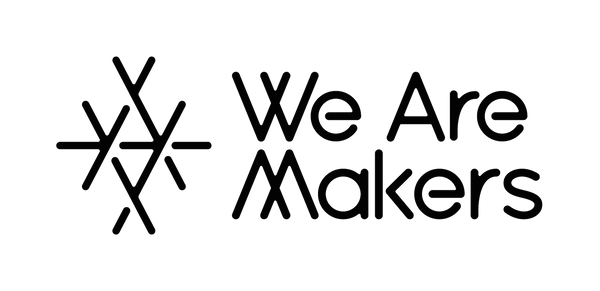
Christopher & Siobhan had a visit from the amazing Kate & Jack from We Are Makers to chat all things STUDIO FLOOR.
We Are Makers is an independent publication showcasing a wide a wide array of wonderful, dedicated, and talented makers from across the globe. Go check them out!
You can watch We Are Makers in Conversation With: Christopher McEvoy & Siobhan McKenna, STUDIO FLOOR below!
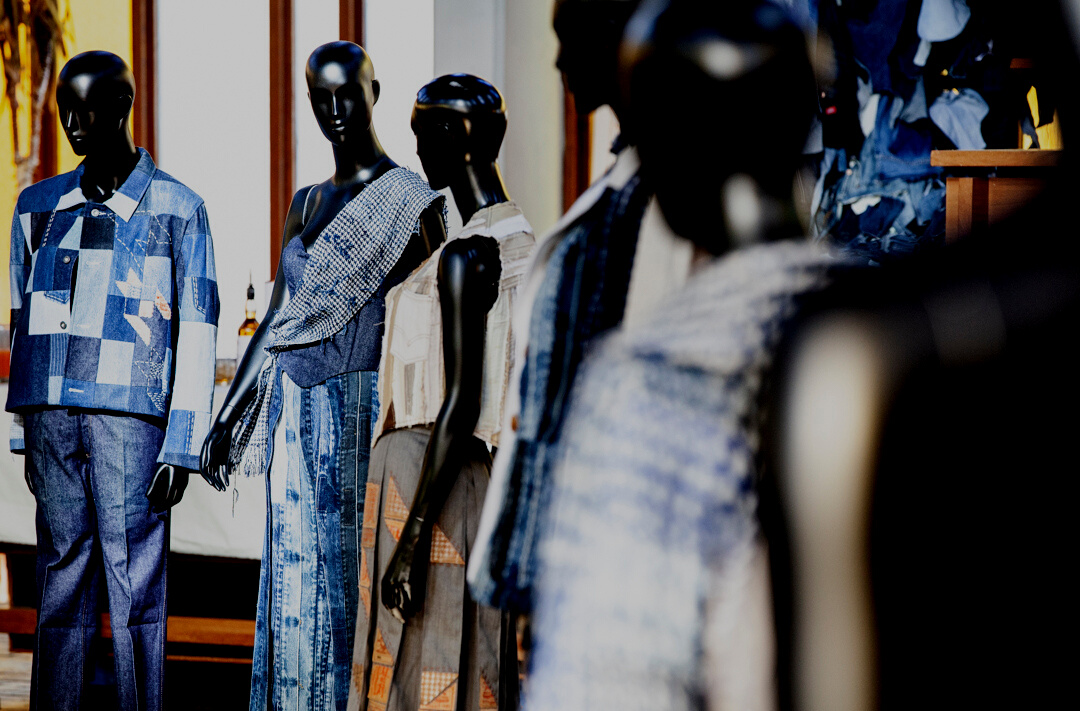
EXHIBTING STUDIO FLOOR
STUDIO FLOOR EXHIBITION | PRIVATE VIEW | THURS 13 APRIL 2023
WITH DRINKS SPONSORSHIP BY
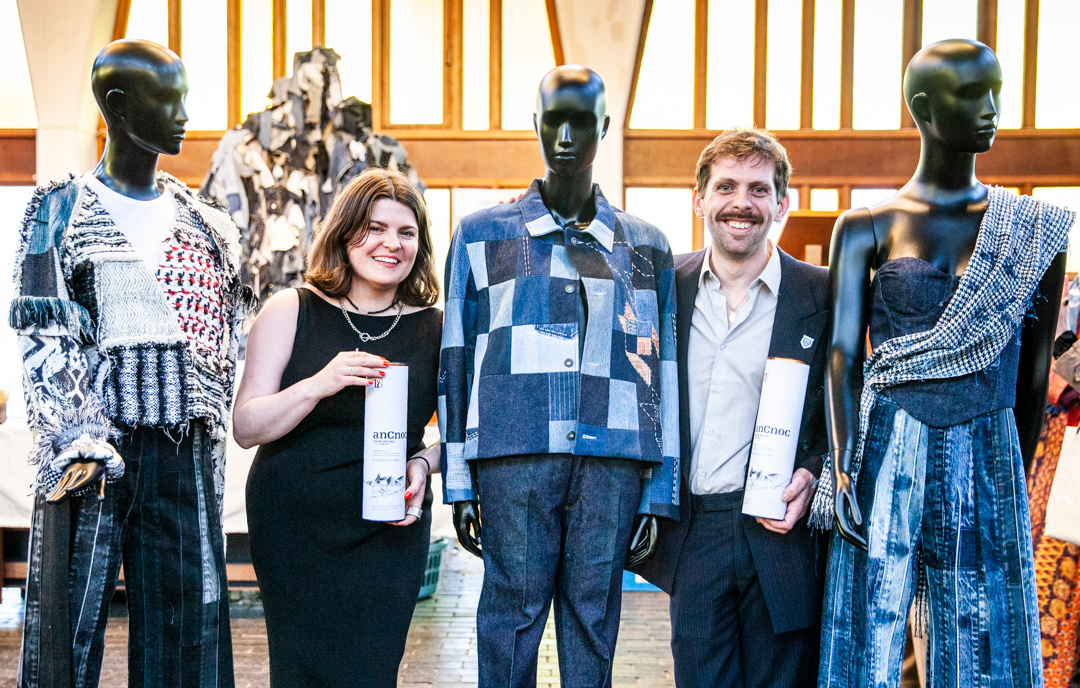
We hosted a private view party to celebrate the opening of the Studio Floor Exhbition in The Pyramid at Anderston on Thursday 13 April 2023. The event was kindly sponsored by anCnoc, who partnered with Siobhan and Chris as they champion artisans.
anCnoc is made at one of the most picturesque distilleries in Scotland, The Knockdhu Distillery, which is situated in the small village of Knock, by Huntly in Aberdeenshire.
The methods used to make anCnoc have hardly changed in over 100 years, and it's these traditional techniques which help to create the distinctive, modern flavour. The craftsmanship has been passed through generations and shared with the world since 1894. anCnoc is a highly respected whisky amongst enthusiasts and a welcoming dram for newcomers.
Sponsoring the opening of the innovative Studio Floor exhibition was a natural partnership for anCnoc as, together with Siobhan and Chris, they value traditional techniques and skills, slow hand-crafted processes and products imbued with personal care and passion. anCnoc were thrilled to support the creativity and commitment Studio Floor have to creating something meaningful and thought provoking by repurposing their discarded fabric and yarn.
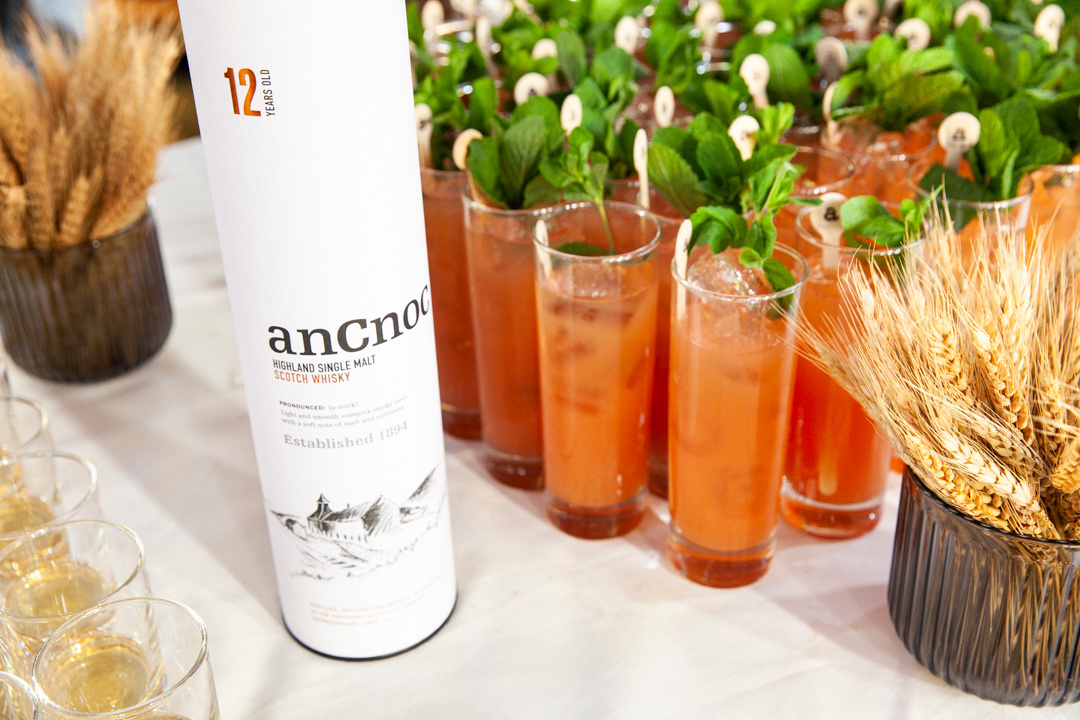
At The Studio Floor exhibition opening, anCnoc served up drams of their 12 Years Old expression, and a delicious cocktail, with sparkling blood orange and mint, that complimented the flavours in the whisky.
anCnoc 12 Years Old is light, yet complex. On the nose it’s soft, very aromatic with a hint of honey and lemon in the foreground. To taste it’s sweet to start with an appetising fruitiness and a long smooth finish. This is a dram that has something for everyone - and the guests who attended the event loved it!
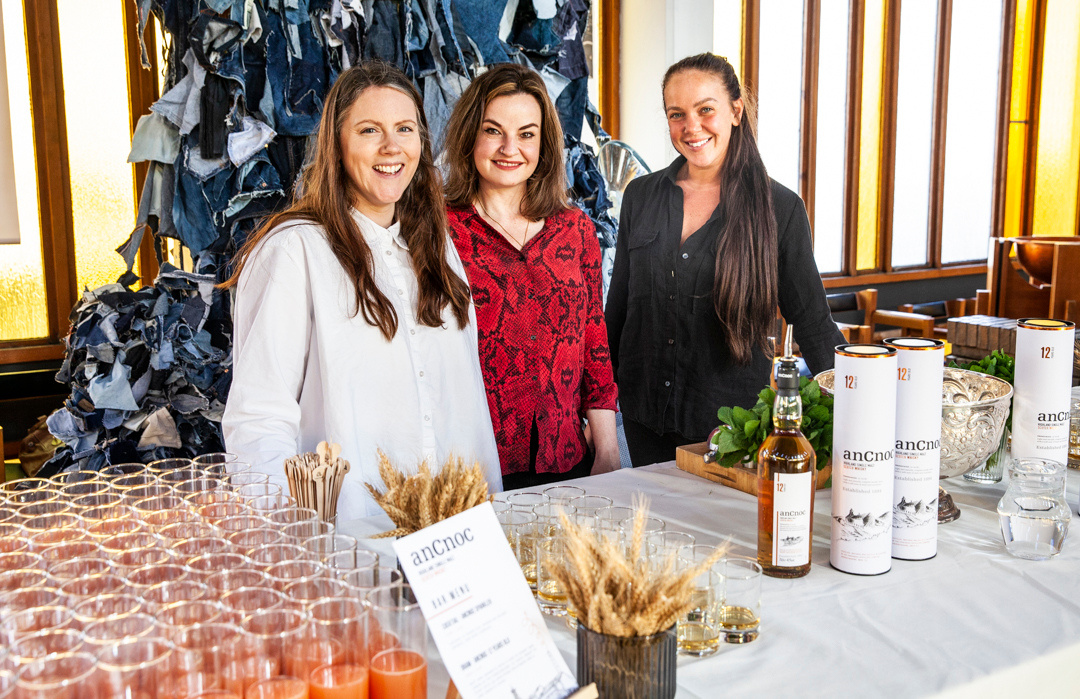
anCnoc Distillery Manager, Gordon Bruce, hosts the anCnoc podcast, Knock Tales, that celebrates the world of craft. Gordon interviews fellow producers to shine a light on the secrets of making beautifully crafted things that stand the test of time. Listen in as Gordon shares a dram with these fellow craft obsessives to get to the bottom of his favourite topic: ‘making things well’. You can listen to the Knock Tales podcast series here.
Christopher & Siobhan extend their greatest thanks to anCnoc for kindly sponsoring the private view of the STUDIO FLOOR Exhibition with their delicious cocktails and drams. They helped to make the evening so special and the guests left happy, and a little merry, in true Scottish fashion! It was the best way to celebrate the launch of the exhibition.
LEARN MORE ABOUT anCnoc
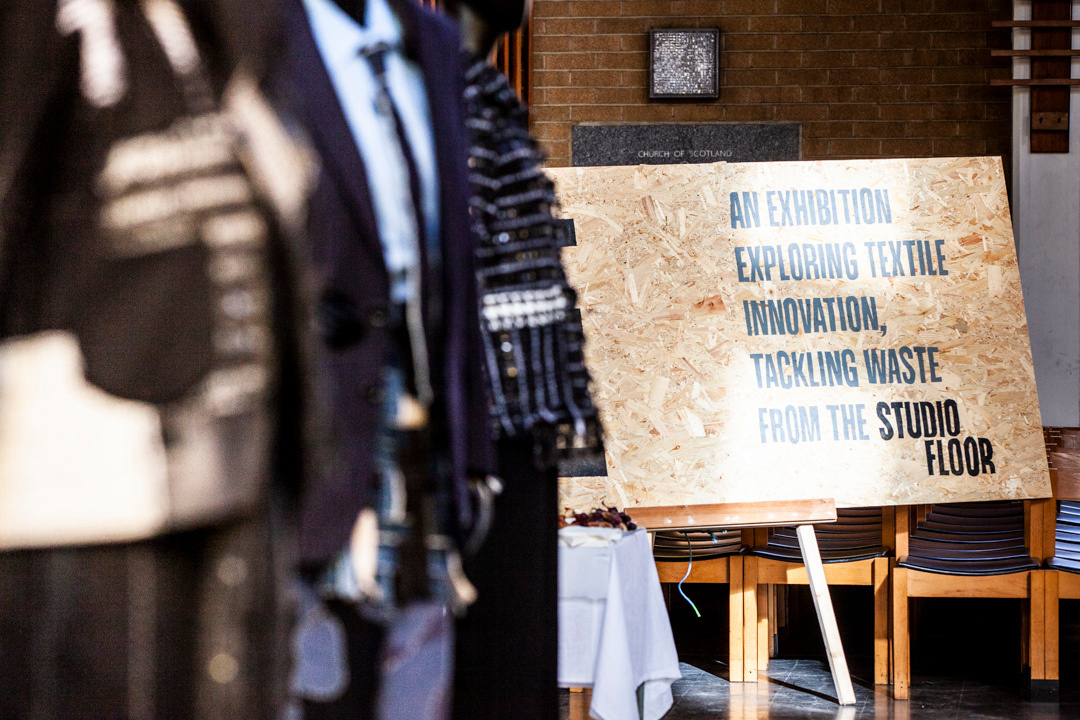
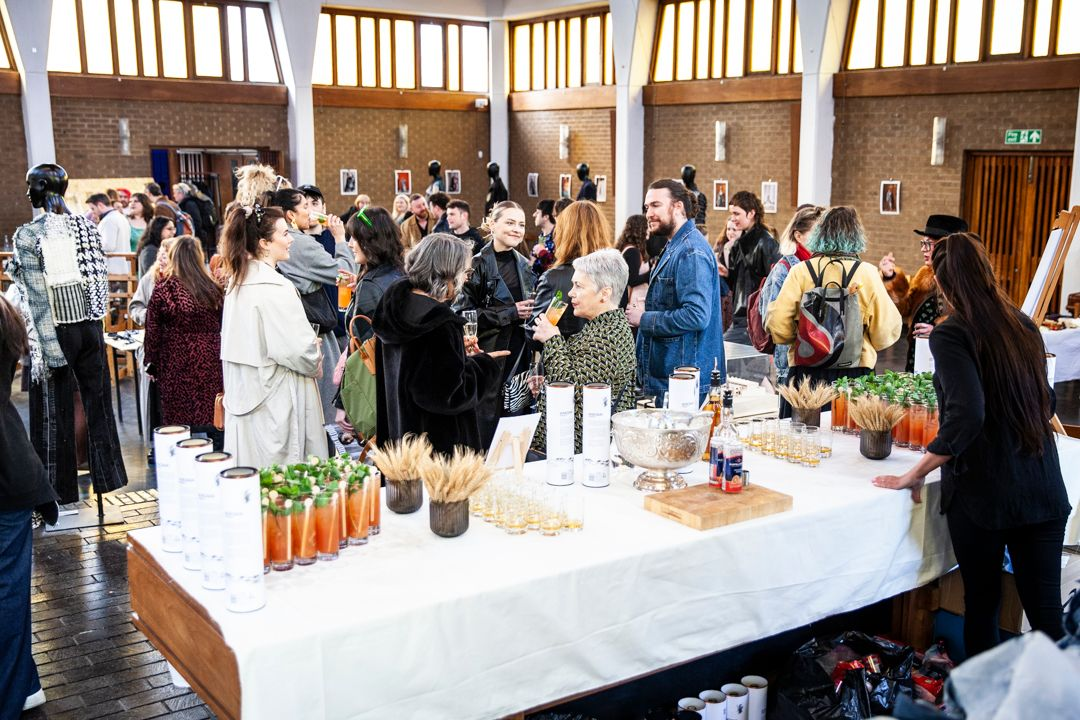
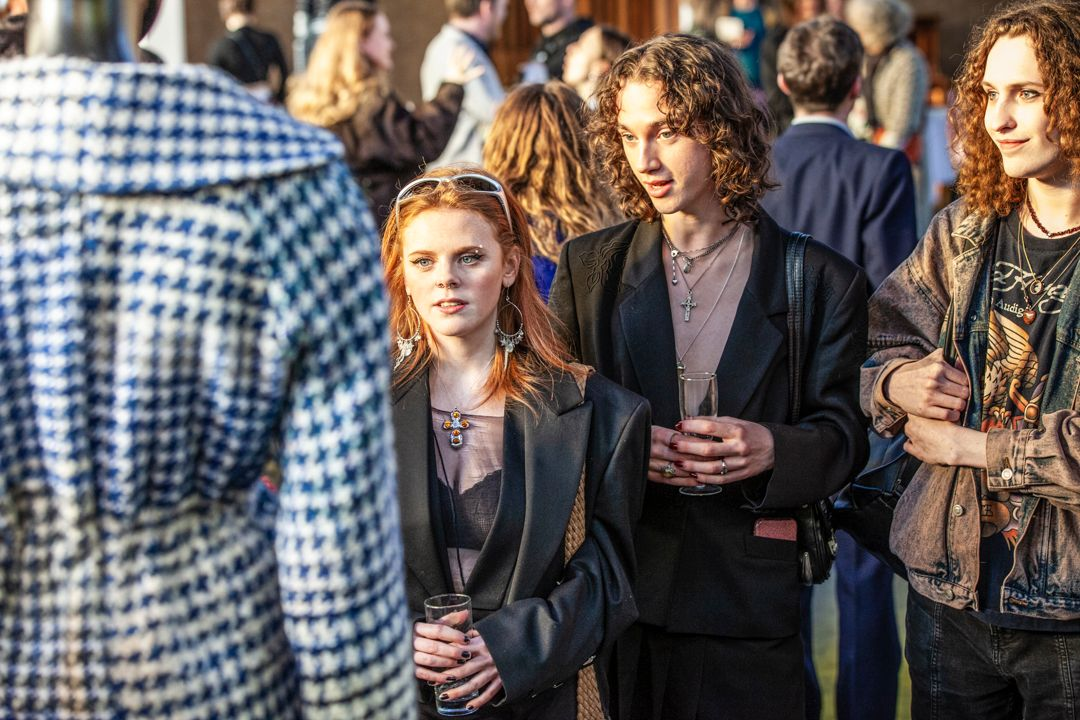
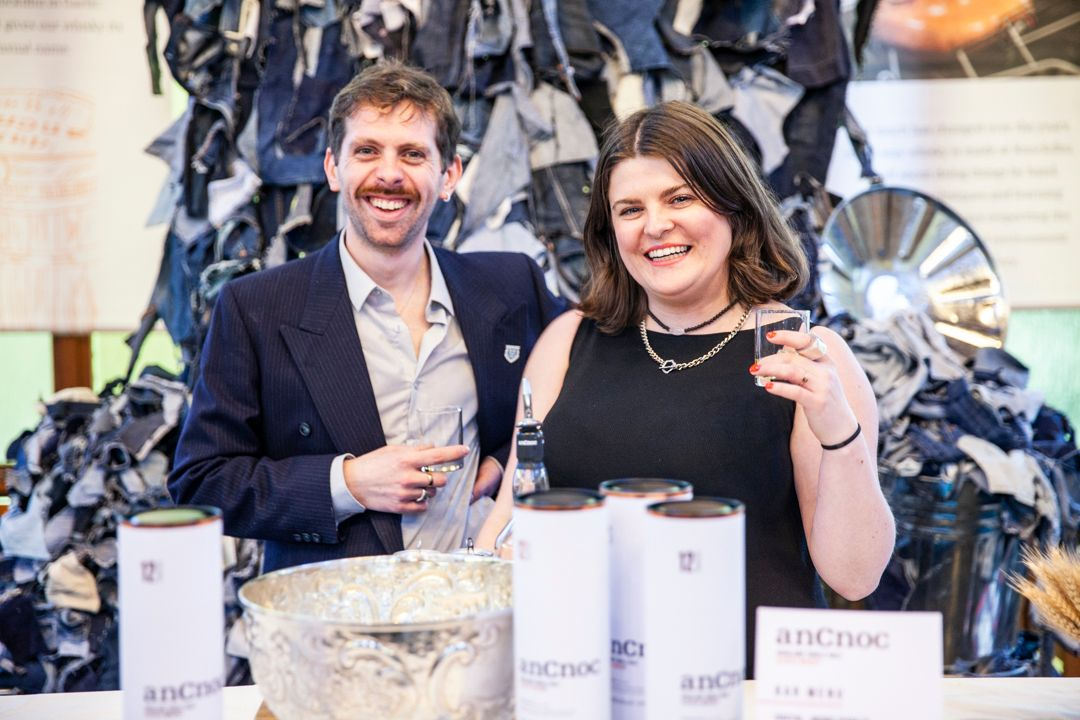
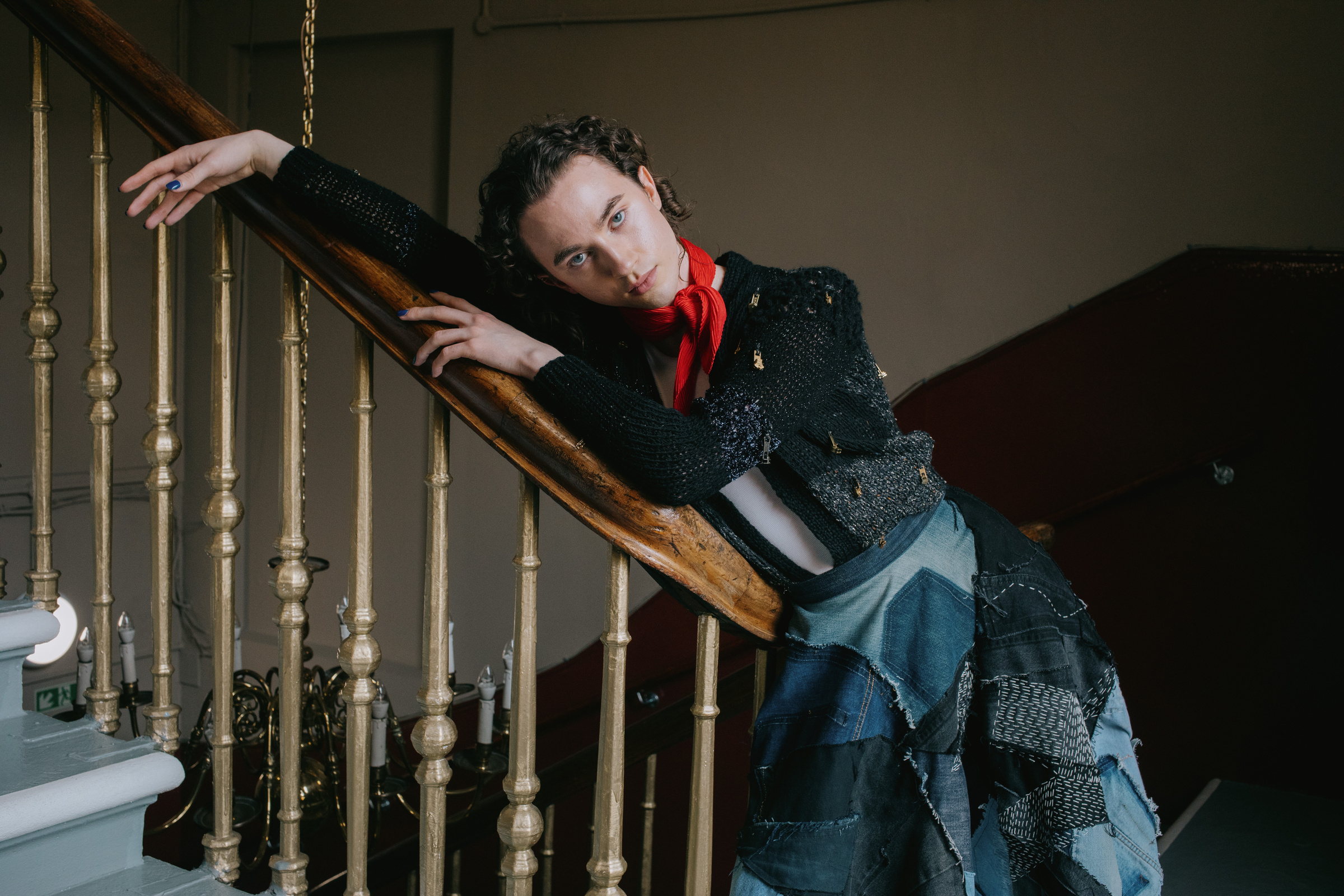
THE COLLECTION
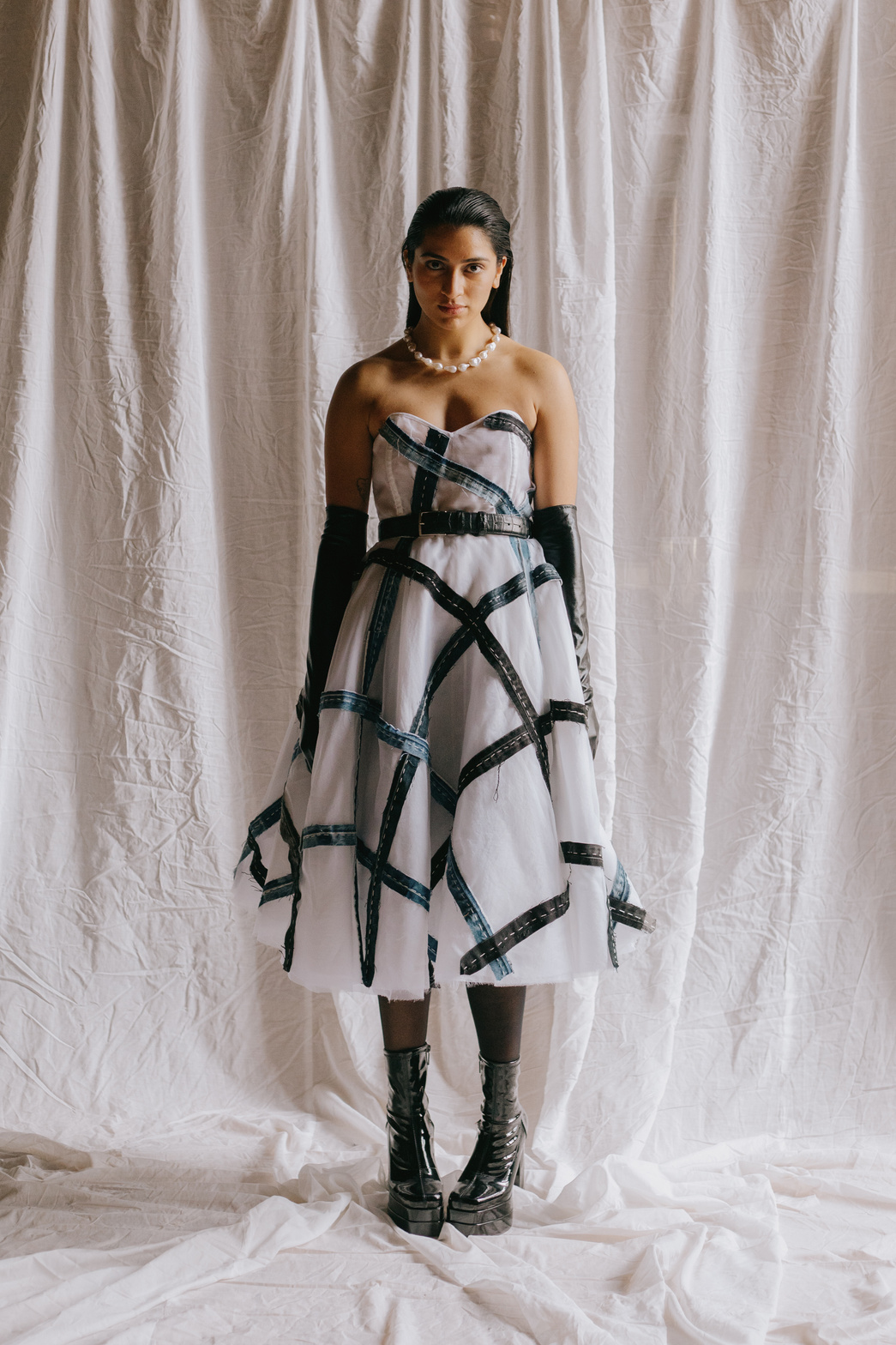
DENIM TARTAN DRESS
Silk organza full circle dress with denim waistband strips in a tartan pattern, embellished by hand with sashiko.
STYLING BY AMANDA BLACKWOOD
RAW HEM PATCHWORK WAISTCOAT | GREY PENCIL SKIRT
A flattering, vertically stitched raw hem waistcoat. Grey New Wool pencil skirt hand embellished with sashiko and jean patch applique, some with a silver houndstooth print, attached in an oversized deconstructed houndstooth pattern.
GLOVES
Waste yarn hand knitted by Maureen McEvoy
LEG WARMERS
Made by Amanda Blackwood from Christopher McEvoy waste studio samples
STYLING BY AMANDA BLACKWOOD
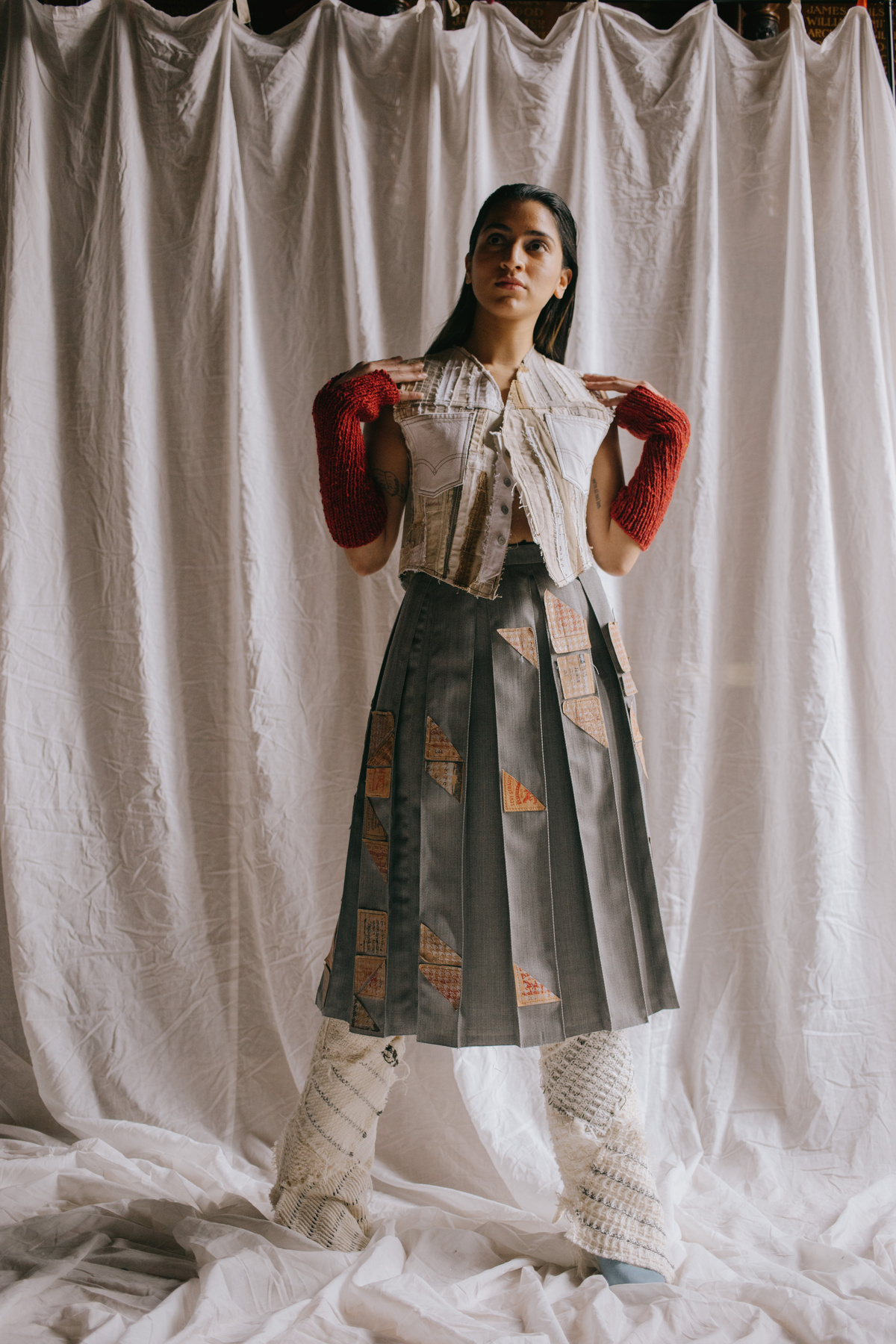
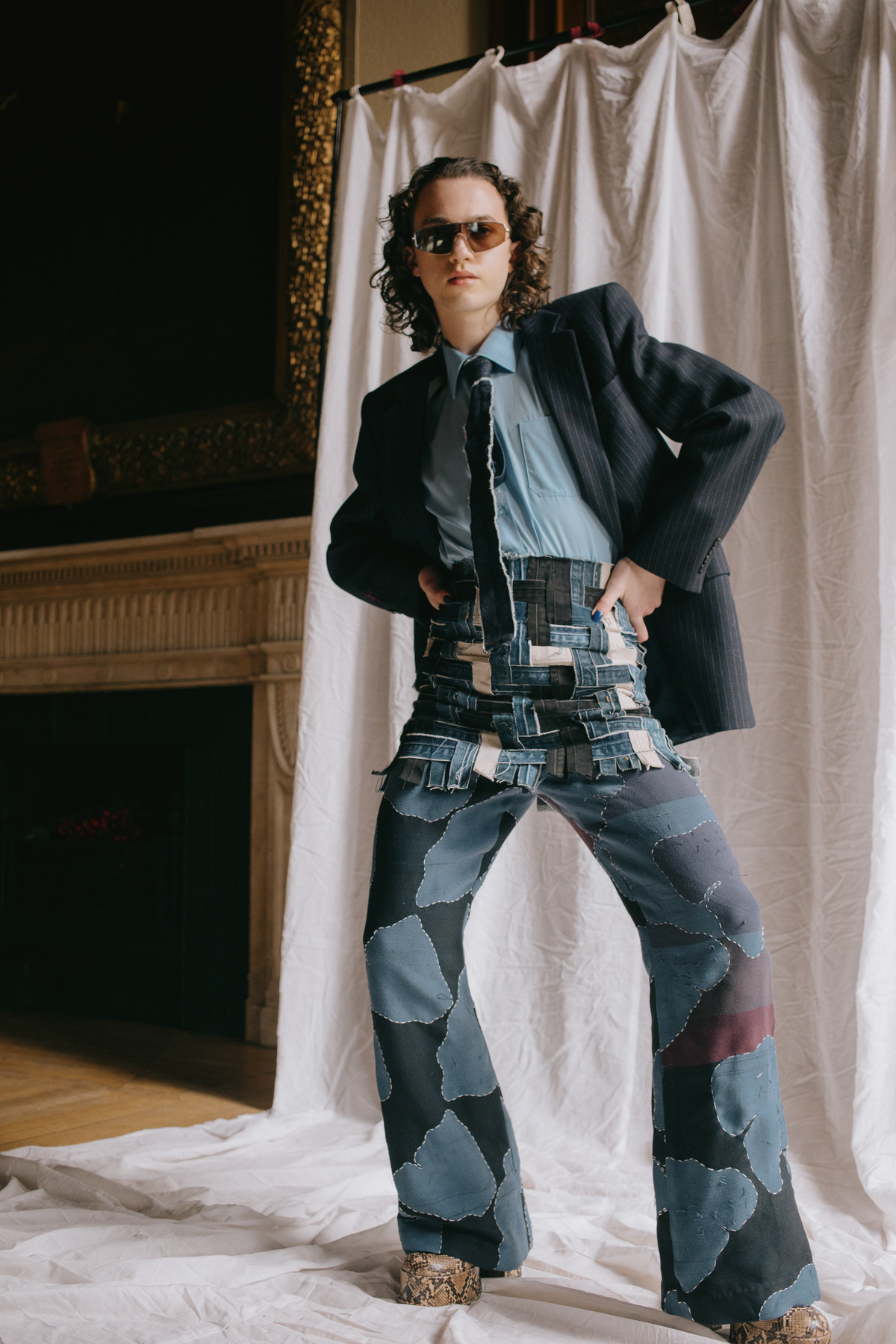
FORM WOVEN DENIM SKIRT | MILL SECONDS BOILED SILK TROUSERS
A form woven denim skirt which was one of the earlier Studio Floor pieces. This thread bare hand woven skirt was created by simply cutting strips of denim with a rotary cutter and weaving together around a dress form and adding in a zip.
The mill seconds boiled silk trousers are made from a faulty test fabric with a Rhubarb leaf pattern. Siobhan and her team embellished the fabric by hand using sashiko to lift the pattern and take your eye away from the imperfections., the point is to create beauty in the imperfect, or ‘wabi sabi’ as the Japanese call it.
JACKET, SHIRT & BOOTS - VINTAGE
STYLING BY AMANDA BLACKWOOD
Scrap Denim Patchwork Jacket
Scrap denim patchwork jacket made using ReJean waste, a Studio floor version of a classic ReJean jacket. The patchwork is cleaner and more intense and embellished with a varied houndstooth pattern which is prominent throughout the collection. We bound the inner edges of the jacket with a Hong Kong finish to contrast the raw internal seams.
JEANS & BOOTS - VINTAGE
STYLING BY AMANDA BLACKWOOD
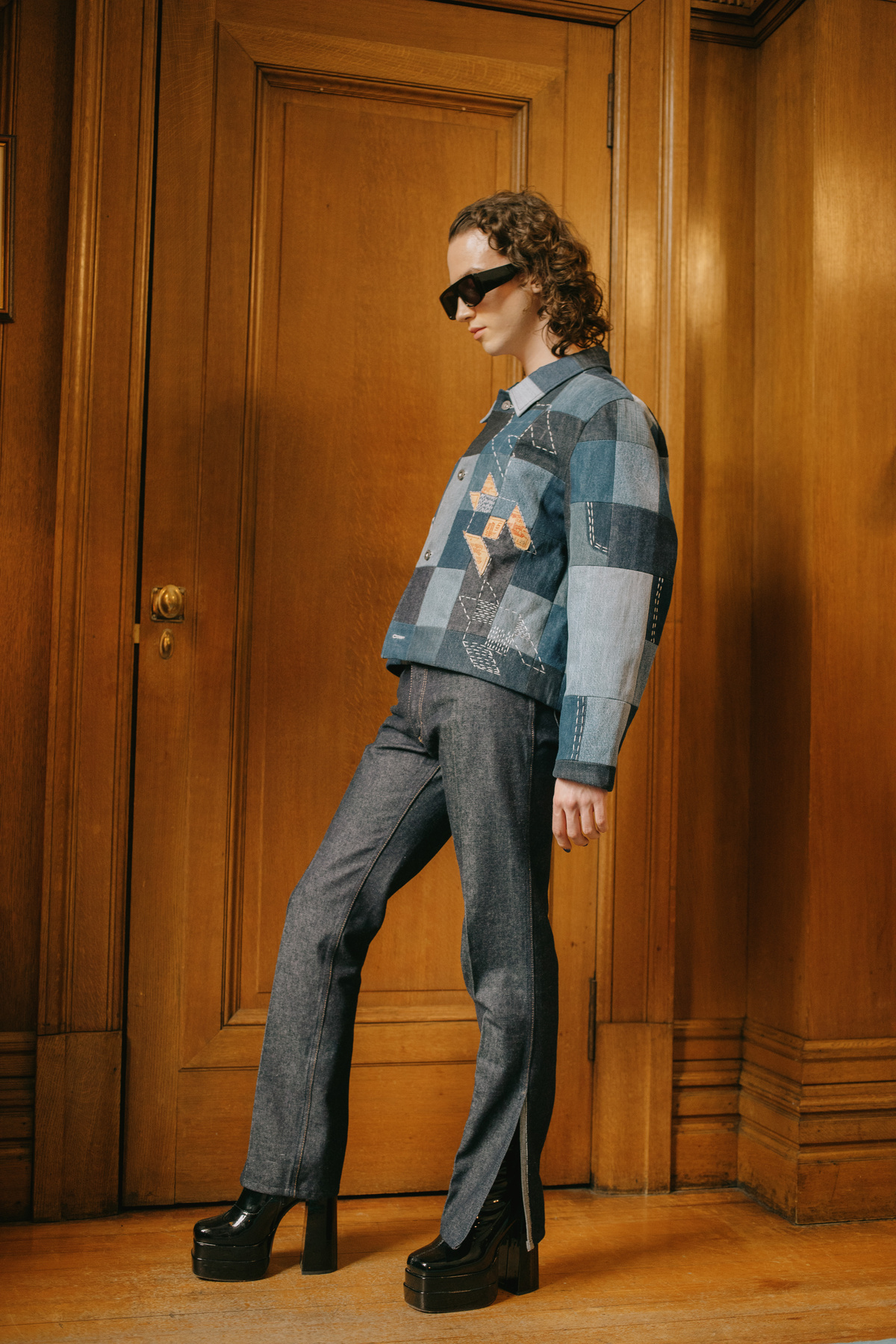
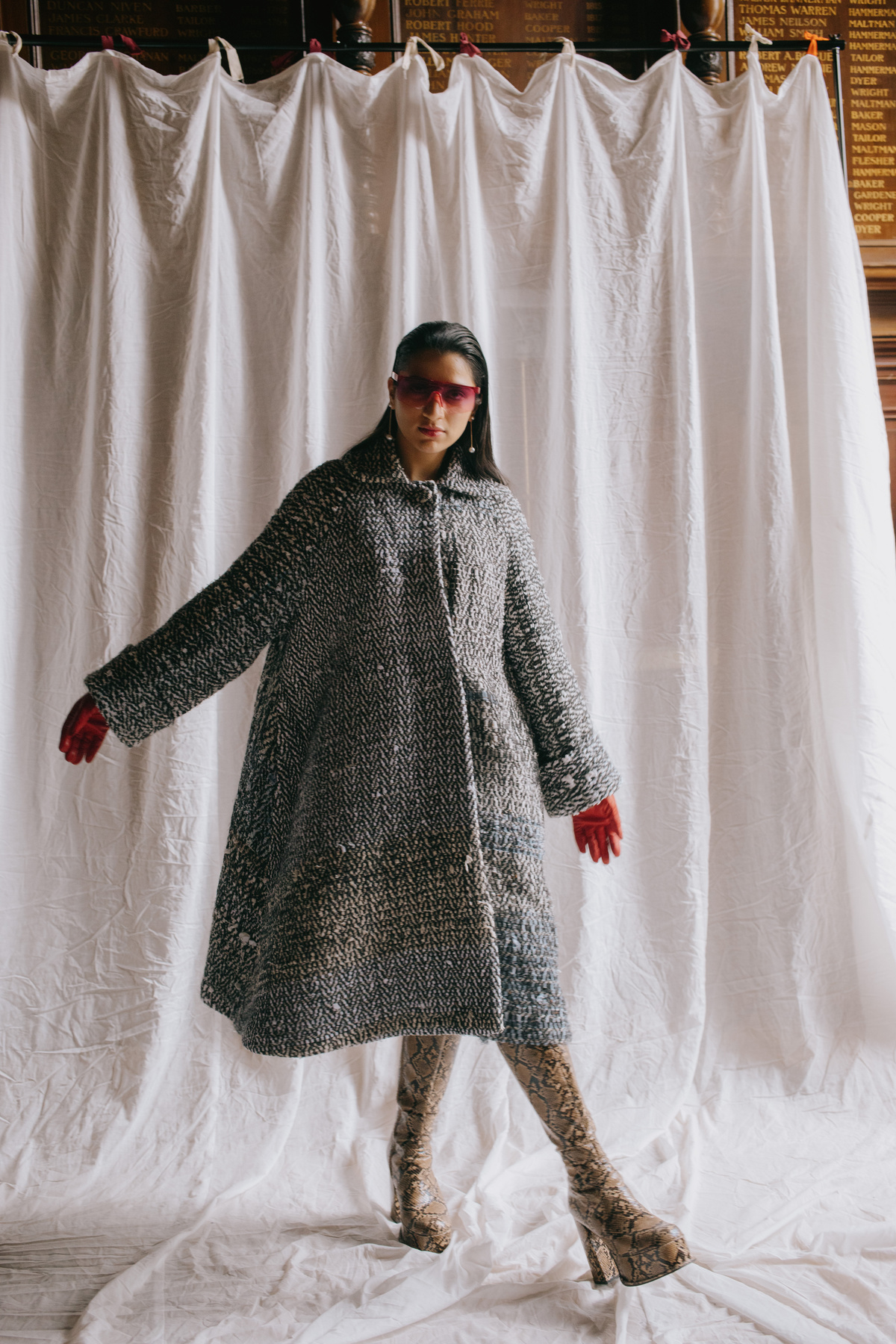
Shredded Denim and waste wool swing coat
Swing Coat inspired BY 1950’s Balenciaga. Recycled silk and wool warp leftover from previous projects woven with hand shredded waste denim in pale blues, creams and whites. Fabric Woven by Christopher McEvoy and Hector Dyer, jacket pattern by Gillie Jean King, cut by Siobhan and sewn by Hazel Corcorran.
STYLING BY AMANDA BLACKWOOD
Raw patchwork denim Skirt | Hand Embellished Sashiko Houndstooth waste Yarn cardigan
Cardigan knitted by Maureen McEvoy using waste yarn from Christopher McEvoy's studio, hand embelished with zip heads from ReJean waste stash.
Raw patchwork denim skirt with two large sashiko houndstooth placements.
STYLING BY AMANDA BLACKWOOD
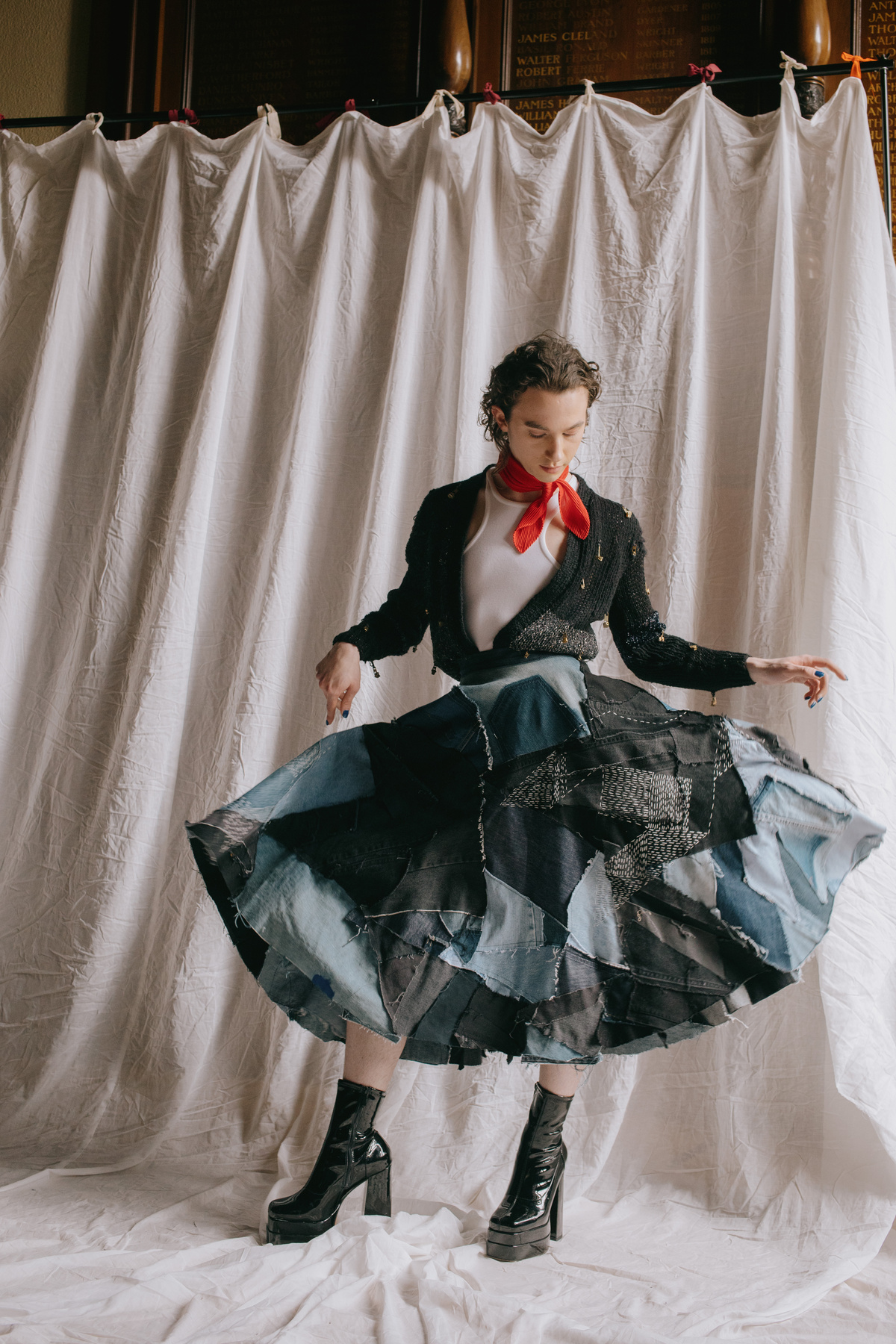
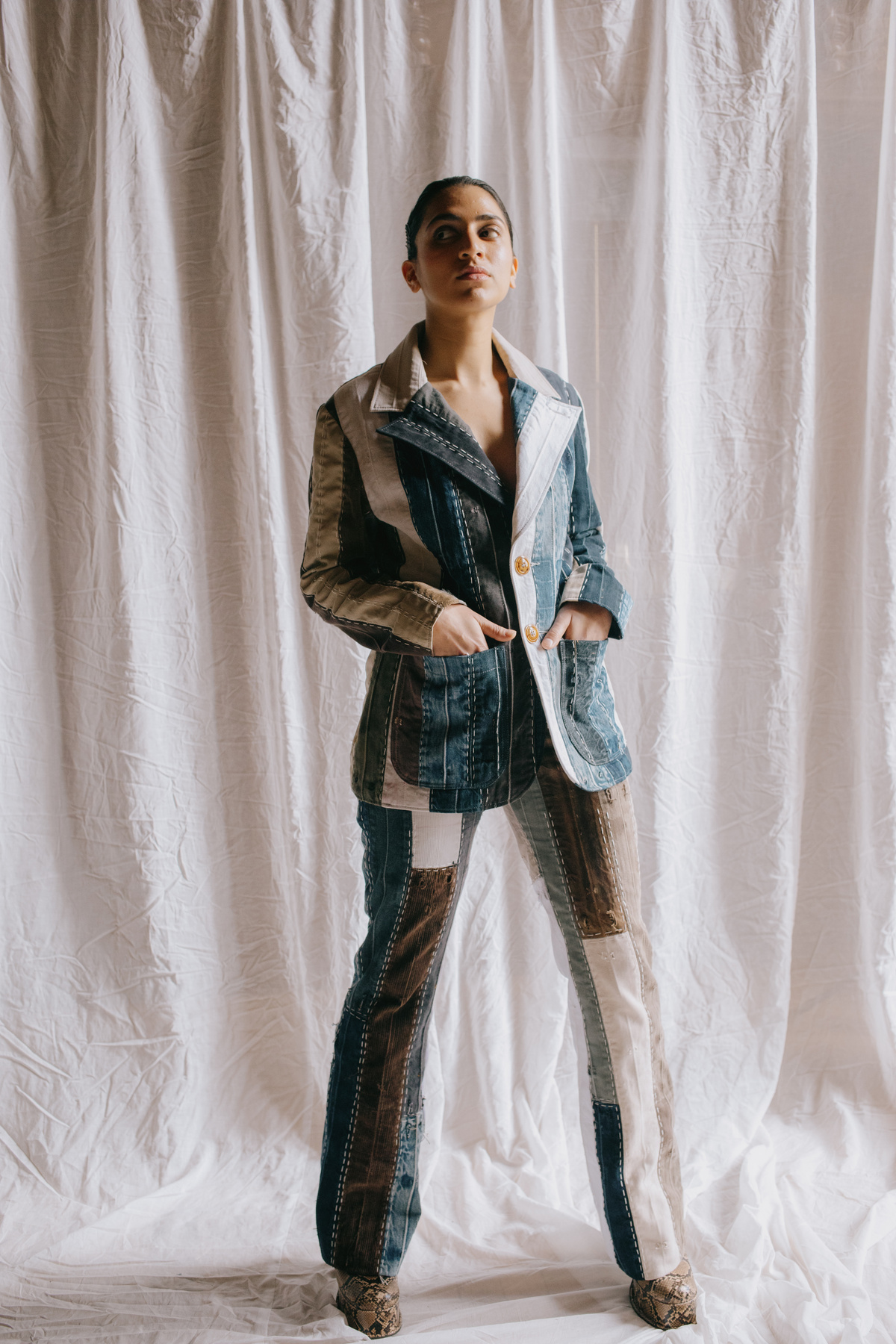
Quilted waistband Suit with Sashiko Detailing
70’s inspired denim jean waistband suit embellished with sashiko to enhance the fabric and make the colours really POP.
STYLING BY AMANDA BLACKWOOD
woven sample jacket | black denim waistband wrap pants
Jacket made from Christopher McEvoy waste fabric samples. Siobhan kept it really raw and messy, her natural response to working with these beautiful couture fabrics. Siobhan sees beauty in the imperfect and raw. Frayed edges are prominent in her work, especially accessories.
Trousers are cut and sewn from a fabric we created from denim waistbands stitched together.
STYLING BY AMANDA BLACKWOOD
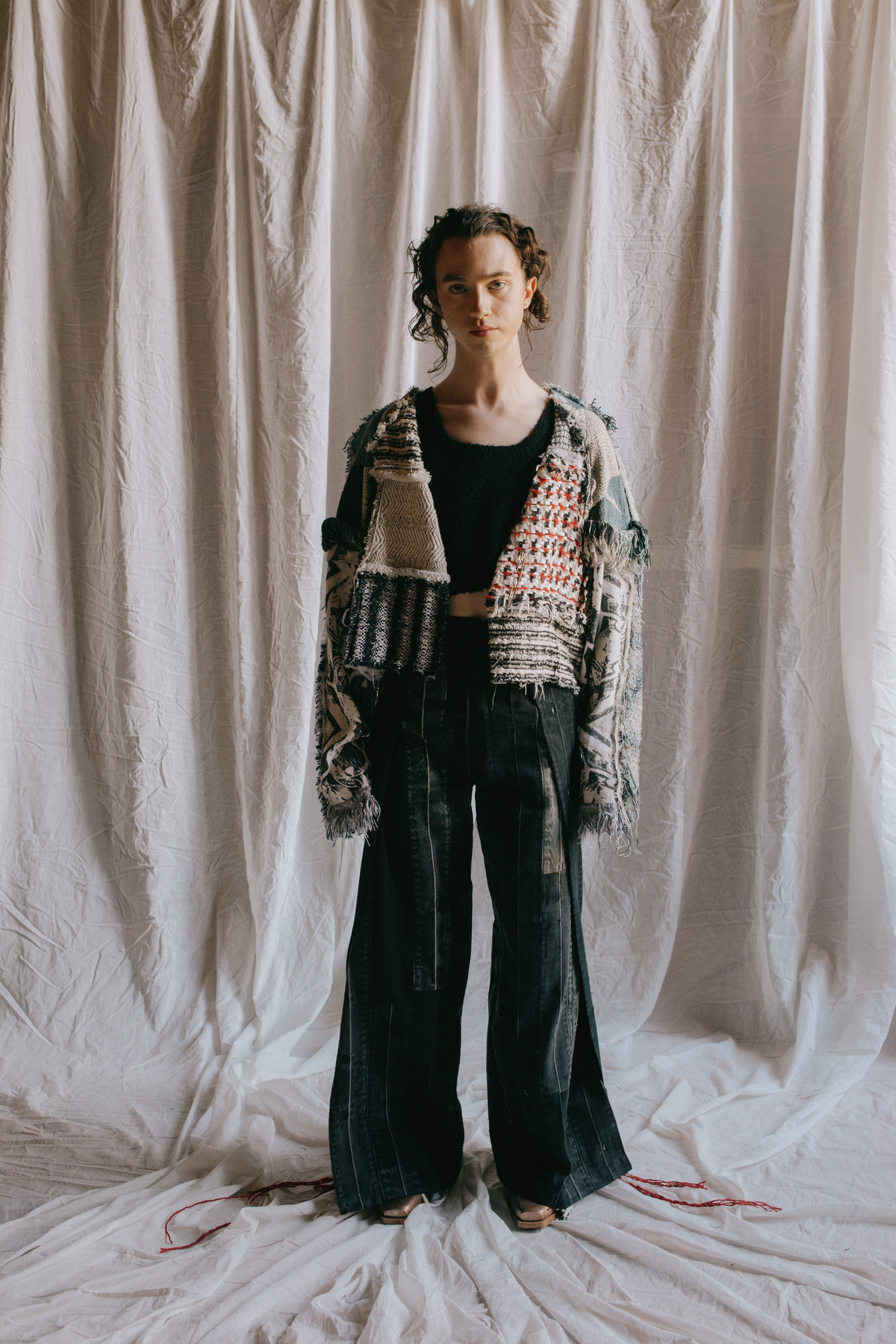
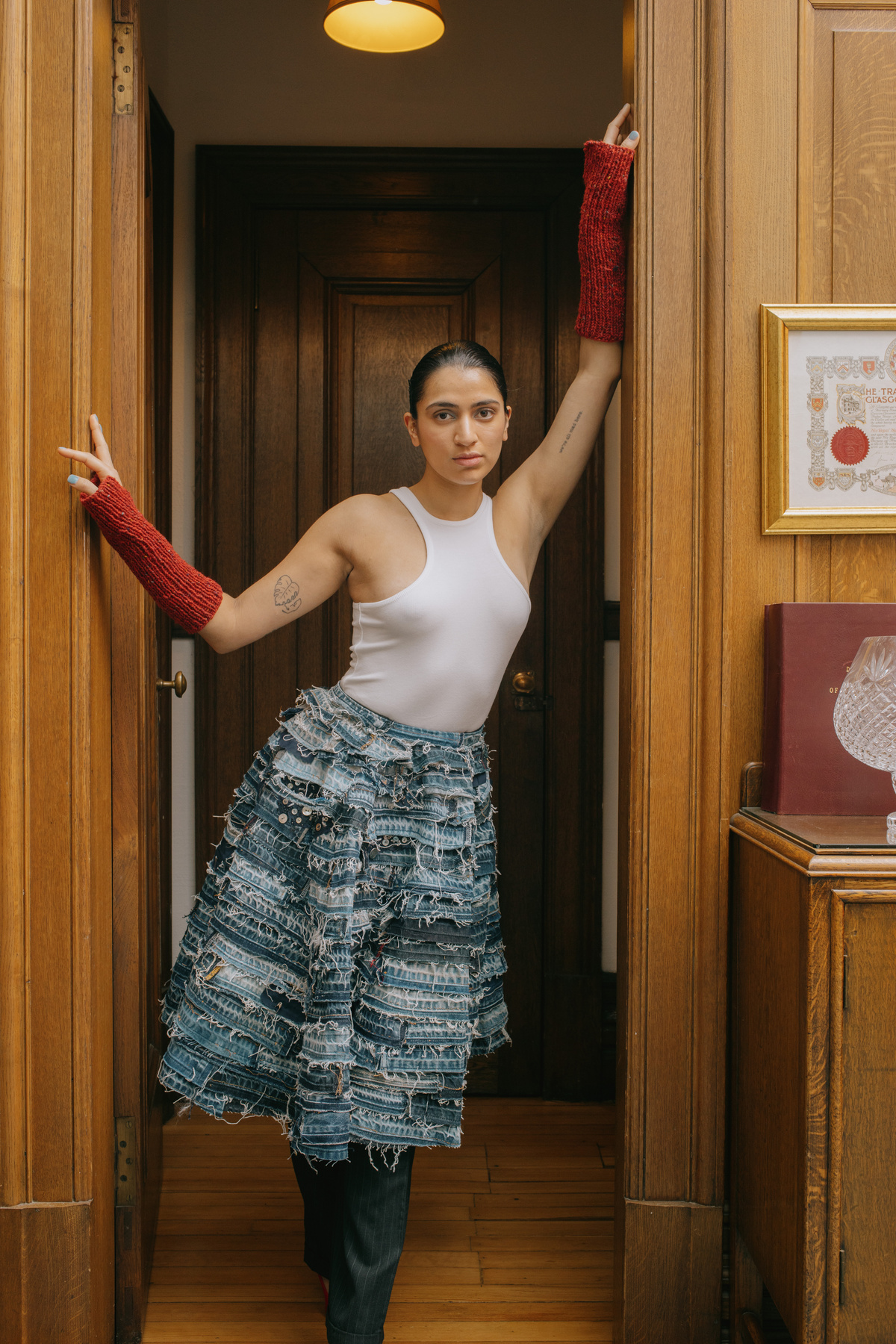
denim hem skirt with vintage buttons
Raw hem skirt embellished with waste yarn and vintage buttons. How many hems do you think we used in total to create this beauty?
STYLING BY AMANDA BLACKWOOD
woven sample and overlocked denim jacket
Black jacket woven by Christopher McEvoy featuring strips of black denim overlocked in white. This jacket was woven entirely from part cones and yarns from previous projects. Siobhan wanted to keep the beautiful raw edges where possible. We patched in some contrasting houndstooth and other fabrics from Christopher's waste sample stash.
STYLING BY AMANDA BLACKWOOD
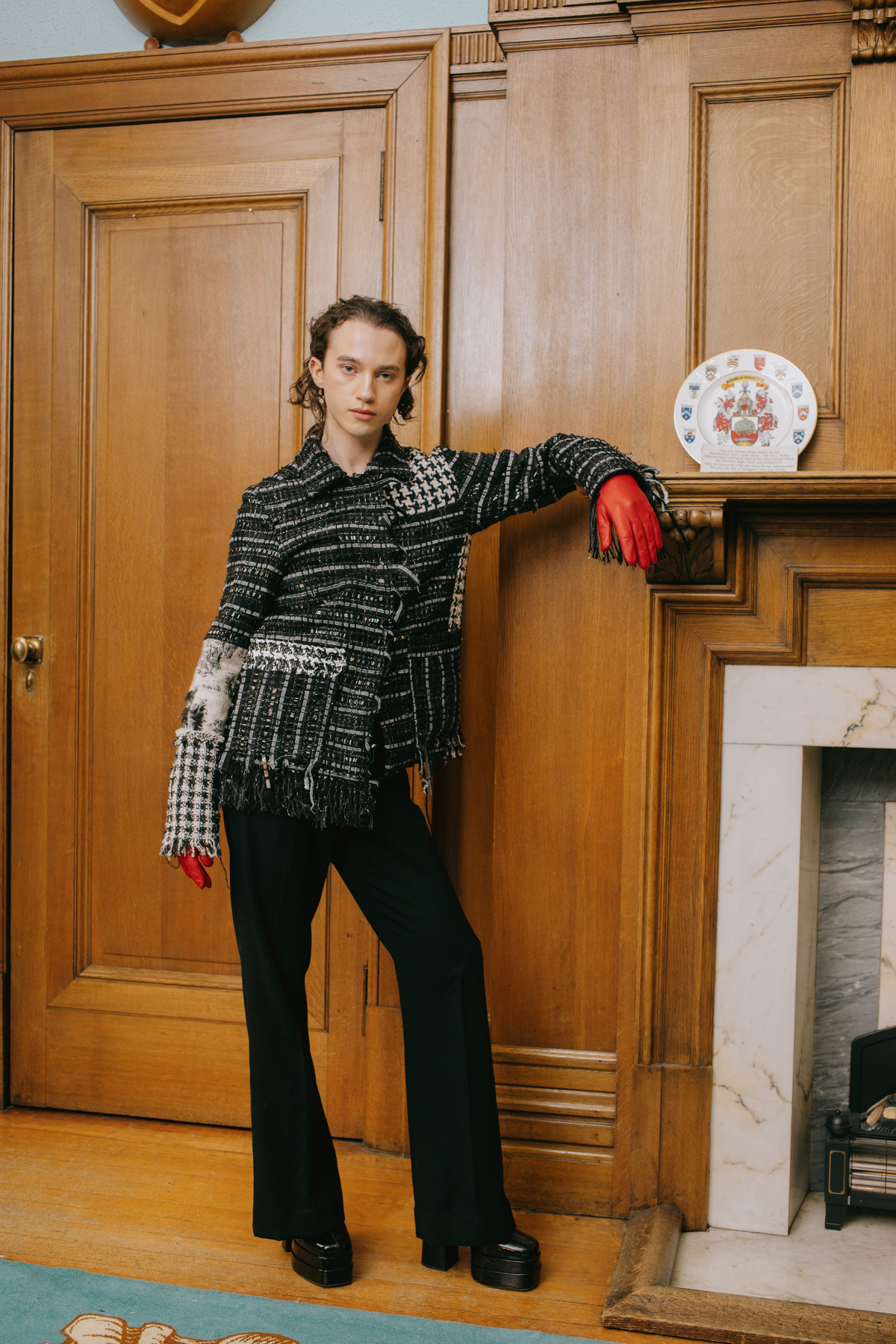
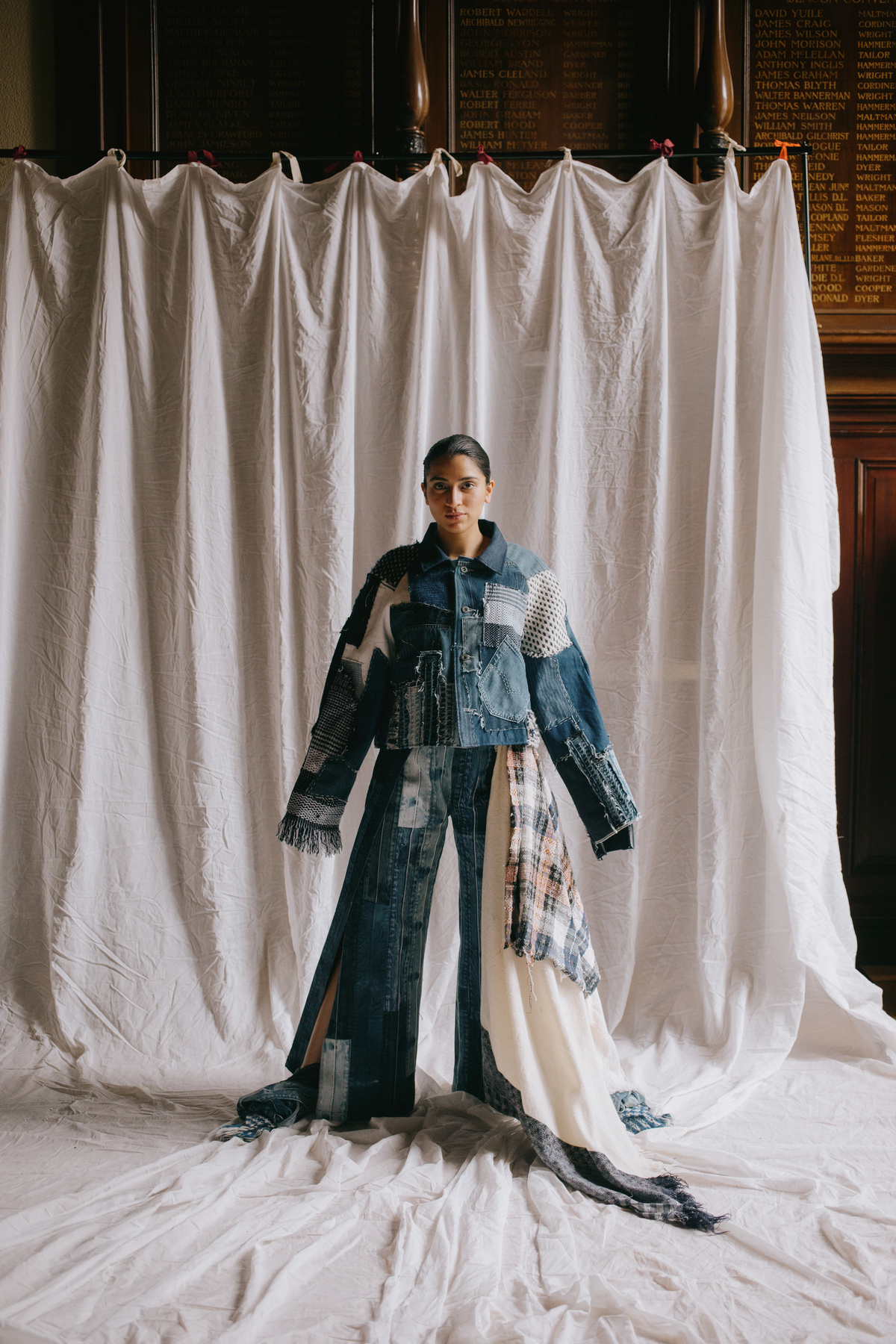
raglan sashiko patchwork jacket | BLUE DENIM WAISTBAND WRAP PANTS
Made using denim and woven samples and hand embellished with Sashiko. Siobhan specialised in patchwork so this is the result when we combine denim scraps and gorgeous woven fabrics together
Styled with our blue denim waistband wrapped pants and draped with Christopher McEvoy studio samples.
STYLING BY AMANDA BLACKWOOD
HOUNDSTOOTH FABRIC SASH | VINTAGE DENIM CORSET | BLUE DENIM WAISTBAND WRAP PANTS
Houndstooth Fabric Sash was intricately woven by Christopher McEvoy using leftover silver yarn and by hand-pulled denim yarn from ReJean denim waste. We originally planned to make a whole dress from this fabric but it was too time consuming to make!
Stunning vintage denim corset, cut and sewn by Gillie Jean King with fabric from a pair of jeans from the ReJean Studio stash.
Blue Wrap pants: we created fabric from denim waistbands. We create a blue palette by stitching all the waistbands together before cutting and sewing into the trousers you see here.
STYLING BY AMANDA BLACKWOOD
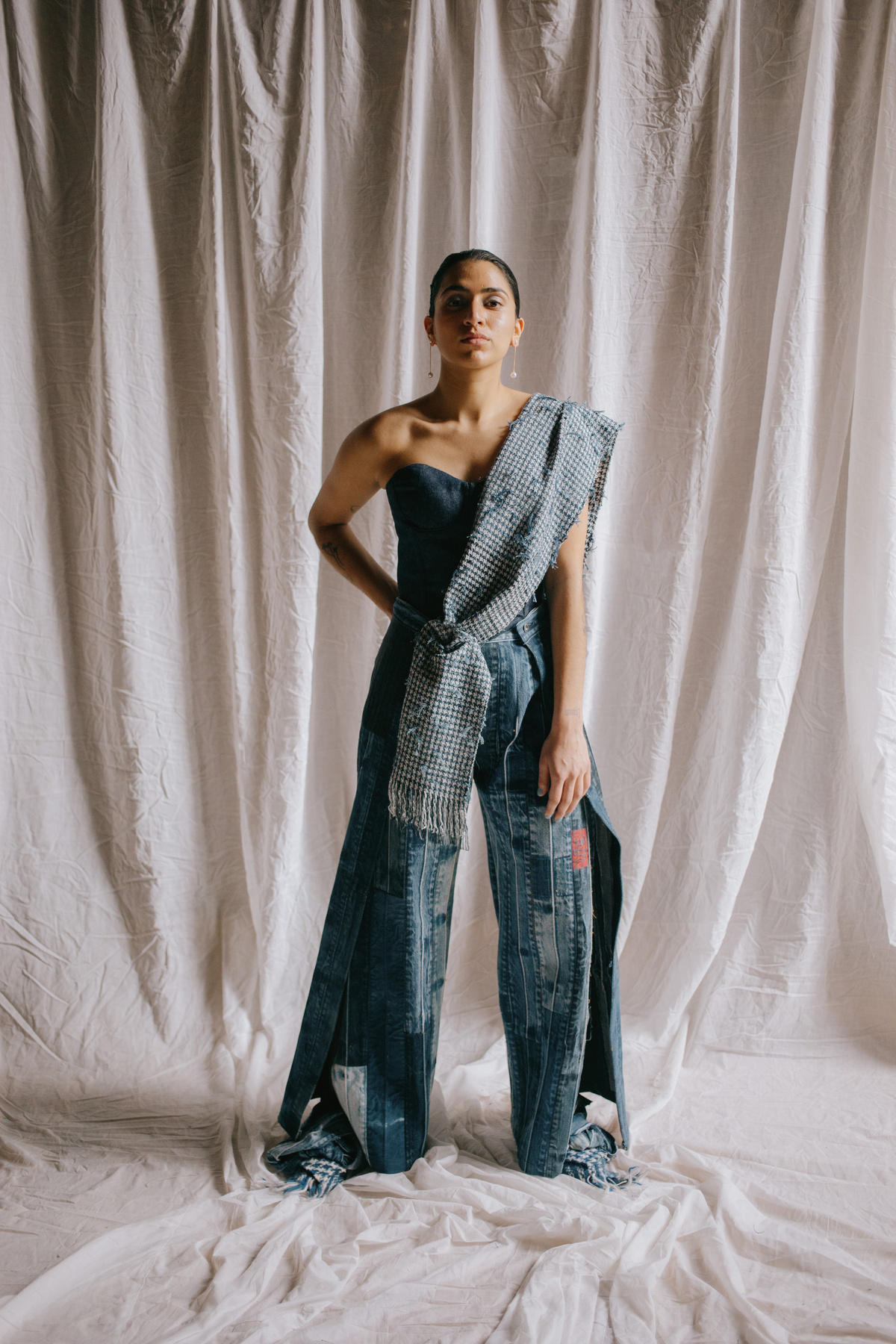
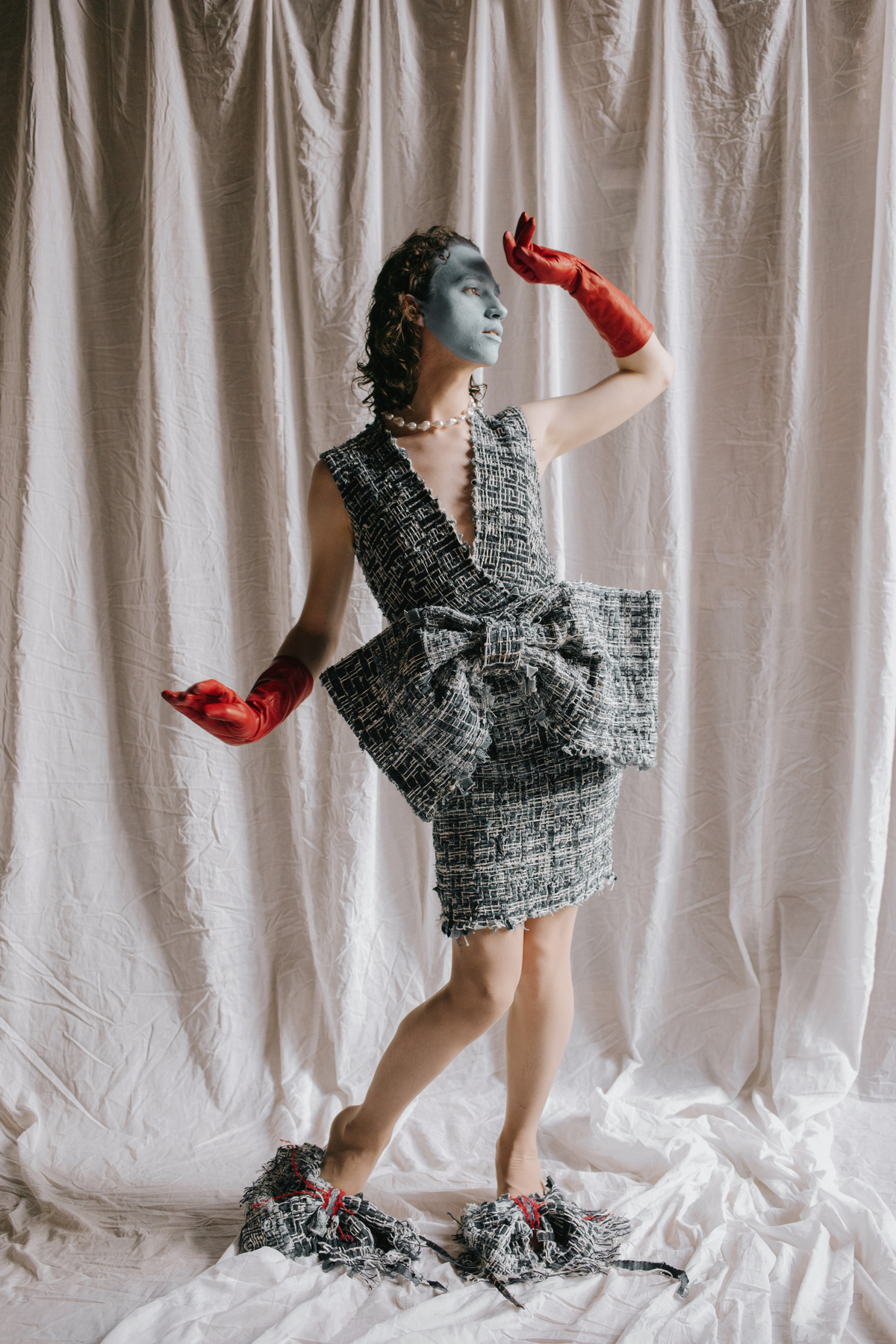
Shredded Denim Weave Dress and Bow | shredded Denim Weave Scrap Shoes
Shredded waste denim from the ReJean studio woven into a glorious fabric by Christopher McEvoy Cut and sewn by Gillie Jean King.
STYLING BY AMANDA BLACKWOOD
waste yarn tweed jacket | woven sample blouse | fabric remnant pumps
This classy AF jacket is made from houndstooth waste fabric woven in a patchwork style. The fabric is woven to look like patchwork by changing the main yarn frequently. Cut and sewn by Siobahn & Hazel in the ReJean Studio.
Fastening made with waste yarn spun by Erin Mcquarrie with vintage button from Siobhan's Grans’ collection.
Jeans: Stylists own embellished with sashiko,
Shoes: Made by Amanda Blackwood with fabric remnants from the Studio Floor collection. No such thing as waste with this project!
STYLING BY AMANDA BLACKWOOD
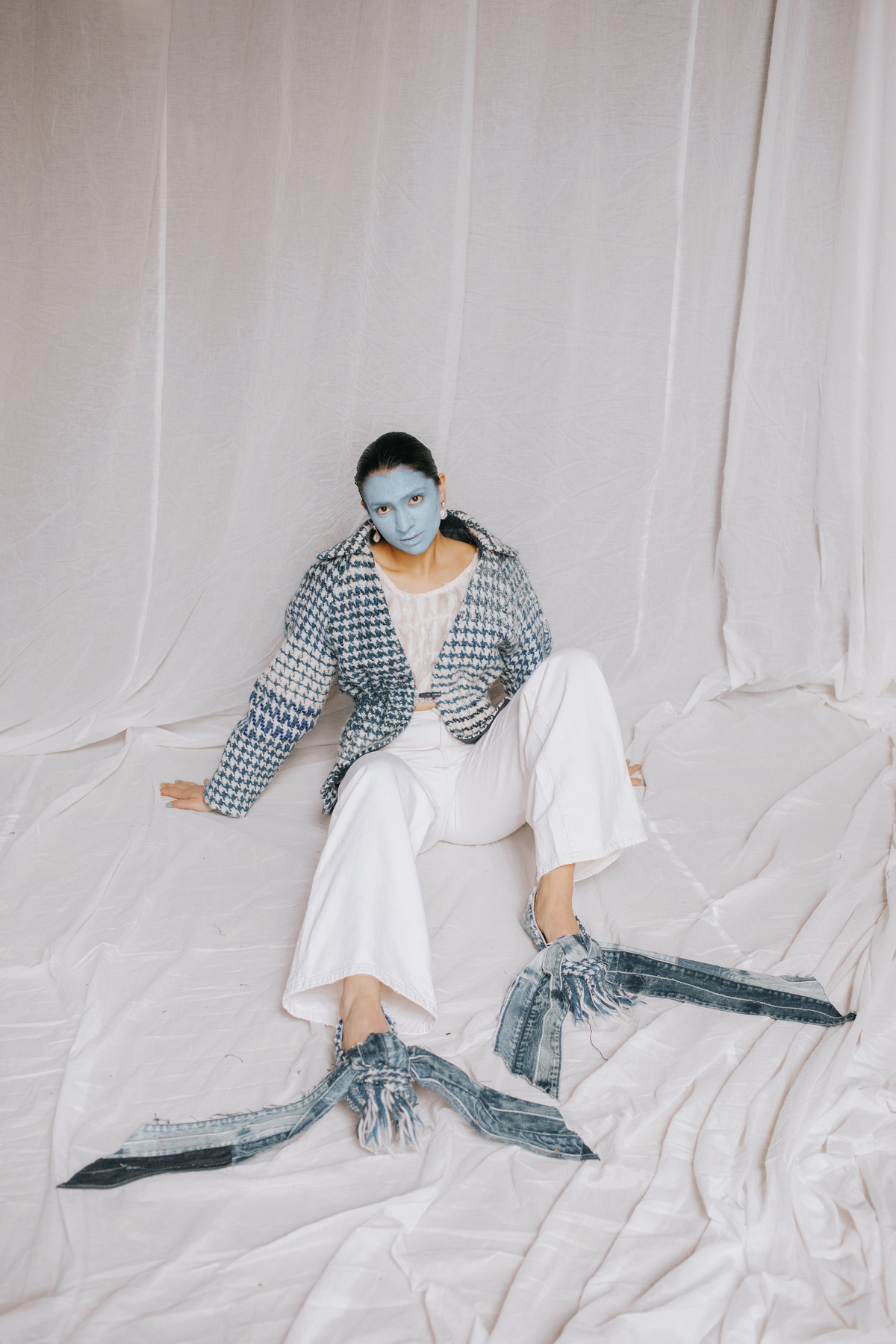
WATCH US TURN TRASH INTO TREASURE & STAY IN THE LOOP WITH ALL THE LATEST FROM STUDIO FLOOR

